Adele
English First Additional Language P3 Grade 12 Questions - NSC Exams Past Papers and Memos September 2019 Preparatory Examinations
INSTRUCTIONS AND INFORMATION
- This question paper consists of THREE sections:
SECTION A: Essay (50)
SECTION B: Longer Transactional Text (30)
SECTION C: Shorter Transactional Text (20) - Answer ONE question from EACH section.
- Write in the language in which you are being assessed.
- Start EACH section on a NEW page.
- You must plan (e.g. using a mind map/diagram/flow chart/key words), edit and proofread your work. The plan must appear BEFORE each text.
- All planning must be clearly indicated as such. It is advisable to draw a line through all planning.
- You are strongly advised to spend approximately:
- 80 minutes on SECTION A
- 40 minutes on SECTION B
- 30 minutes on SECTION C
- Number the answers correctly according to the numbering system used in this question paper.
- Give each response a suitable title/heading.
- Do NOT consider the title/heading when doing a word count. 11. Write neatly and legibly.
QUESTIONS
SECTION A: ESSAY
QUESTION 1
- Write an essay of between 250 and 300 words in length on ONE of the following topics.
- Write down the NUMBER and TITLE of the essay you have chosen correctly, for example 1.1 My enemy has become my friend and …
- Give your OWN title if your choice is QUESTION 1.7.1 OR 1.7.2.
- Spend approximately 80 minutes on this section.
1.1 My enemy has become my friend and … [50]
1.2 Possibilities for me in the future [50]
1.3 Unbelievable! [50]
1.4 Doing what is right is not always popular. [50]
1.5 ‘You cannot change the past, but you can make a difference now.’ – Avis J. Williams. [50]
1.6 Security cameras tend to violate privacy. [50]
1.7 Choose ONE of the following pictures and write an essay on a topic that comes to mind. Write the question number (1.7.1 OR 1.7.2) and give your essay a suitable title.
NOTE: There must be a clear link between your essay and the picture you have chosen.
1.7.1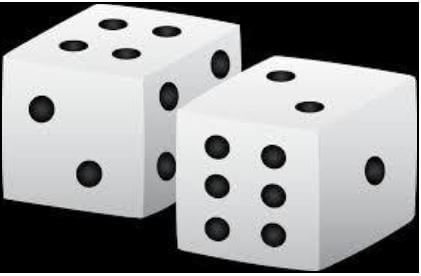
[Source: googlepictures.com] [50]
OR
1.7.2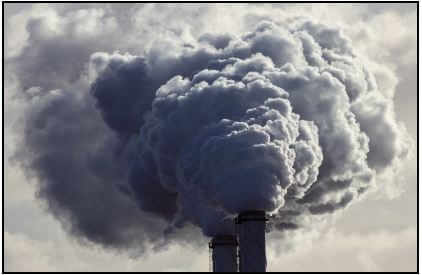
[Source: googlepictures.com] [50]
TOTAL SECTION A: 50
SECTION B: LONGER TRANSACTIONAL TEXT
QUESTION 2
- Respond to ONE of the following longer transactional writing texts.
- The body of your response should be between 120 and 150 words in length.
- Write down the NUMBER and the HEADING of the text you have chosen, for example:
2.1 FRIENDLY LETTER.
- Pay particular attention to format, language and register.
- Spend approximately 40 minutes on this section.
2.1 FRIENDLY LETTER
You borrowed a textbook from a friend who lives very far from you. He/She had already returned home when you realised that you had not returned the book to him/her.
Write a letter to your friend in which you apologise for your mistake and explain how you are going to send the textbook back to him/her. [30]
2.2 DIALOGUE
Your sister has expressed her intention to join a girls’ soccer team, but your father/mother is not happy with her decision. Your sister has asked you to speak to your father/mother.
Write the conversation that took place between you and your father/mother. NOTE: Use the dialogue format. [30]
2.3 OBITUARY
Your best friend has passed away after a short illness. His/her family has asked you to write the obituary.
Write the obituary to inform others about his/her death. You must also pay tribute to him/her. [30]
2.4 NEWSPAPER ARTICLE
There was a service delivery protest in your city. Public property such as government offices, vehicles were damaged.
Write a newspaper article in which you express your dissatisfaction with the behaviour of the protesters. Also show why it is not necessary to engage in unacceptable behaviour when protesting. [30]
TOTAL SECTION B: 30
SECTION C: SHORTER TRANSACTIONAL TEXT
QUESTION 3
- Choose ONE of the following topics and write a short transactional text.
- The body of your response should be between 80 and 100 words in length.
- Write down the NUMBER and the HEADING of the text you have chosen, for example: 3.1 FLYER.
- Spend approximately 30 minutes on this section.
3.1 FLYER
You and your classmates want to raise funds to buy matric tracksuits. You have decided to sell some items.
Write out the flyer in which you describe in detail the items you are going to sell.
NOTE: No marks are awarded for drawings or illustrations. [20]
3.2 DIARY ENTRIES
You have recently been elected as the chairperson of your local cultural club. You have to deliver an acceptance speech.
Write TWO diary entries in which you express how you felt BEFORE and AFTER delivering your speech. [20]
3.3 DIRECTIONS
Your friend who stays in another city wants to visit your local Youth Centre in your town.
Write out the directions from the bus terminus in your town to the Youth Centre.
You must include landmarks, approximate distances and specific directions in your response.
NOTE: No marks are awarded for drawings or illustrations. [20]
TOTAL SECTION C: 20
GRAND TOTAL: 100
English First Additional Language P2 Grade 12 Questions - NSC Exams Past Papers and Memos September 2019 Preparatory Examinations
INSTRUCTIONS AND INFORMATION
Read this page carefully before you begin to answer the questions.
- Do NOT attempt to read the entire question paper. Consult the TABLE OF CONTENTS on the next page and mark the numbers of the questions set on texts you have studied this year. Read these questions carefully and answer as per the instructions.
- This question paper consists of FOUR sections:
SECTION A: Novel (35)
SECTION B: Drama (35)
SECTION C: Short Stories (35)
SECTION D: Poetry (35) - Answer questions from TWO sections, as follows:
SECTION A: NOVEL
Answer the question on the novel you have studied.
SECTION B: DRAMA
Answer the question on the drama you have studied.
SECTION C: SHORT STORIES
Answer the questions set on BOTH extracts.
SECTION D: POETRY
Answer the questions set on BOTH poems.
Use the checklist on page 4 to assist you. - Follow the instructions at the beginning of each section carefully.
- Number the answers correctly according to the numbering system used in this question paper.
- Start EACH section on a NEW page.
- Spend approximately 60 minutes on each section.
- Write neatly and legibly.
SECTION A: NOVEL
Answer ANY ONE question on the novel you have studied.
QUESTION | QUESTION | MARKS | PAGE | |||||
1. | Cry, the Beloved Country | Contextual questions | 35 | 5 | ||||
OR | ||||||||
2. | Strange Case of Dr Jekyll and Mr Hyde | Contextual questions | 35 | 9 | ||||
SECTION B: DRAMA | ||||||||
3. | Macbeth | Contextual questions | 35 | 13 | ||||
OR | ||||||||
4. | My Children! My Africa! | Contextual questions | 35 | 17 | ||||
SECTION C: SHORT STORIES | ||||||||
5.1 | ‘Transforming Moments’ | Contextual question | 18 | 21 | ||||
AND | ||||||||
5.2 | ‘The Last Breath’ | Contextual question | 17 | 23 | ||||
SECTION D: POETRY | ||||||||
6.1 | ‘Alexandra’ | Contextual question | 18 | 25 | ||||
AND | ||||||||
6.2 | ‘Death’ | Contextual question | 17 | 27 | ||||
CHECKLIST
NOTE:
- Answer questions from ANY TWO sections.
- Tick (✓) the sections you have answered.
SECTION | QUESTION NUMBERS | NO. OF QUESTIONS TO ANSWER | TICK (✓) |
A: Novel | 1–2 | 1 | |
B: Drama | 3–4 | 1 | |
C: Short Stories | 5 | 1 | |
D: Poetry | 6 | 1 |
NOTE: Ensure that you have answered questions on TWO sections only.
QUESTIONS
SECTION A: NOVEL
In this section, questions are set on the following novels:
- CRY, THE BELOVED COUNTRY by Alan Paton
- STRANGE CASE OF DR JEKYLL AND MR HYDE by Robert Louis Stevenson
Answer ALL the questions on the novel that you have studied.
QUESTION 1: CRY, THE BELOVED COUNTRY
Read the extracts from the novel below and answer the questions set on each. The number of marks allocated to each question serves as a guide to the expected length of your answer.
NOTE: Answer the questions set on BOTH extracts, i.e. QUESTION 1.1 AND QUESTION 1.2.
1.1 EXTRACT A
[Stephen Kumalo and Msimangu are looking for Kumalo’s sister.]
-That is the building of the Bantu Press, our newspaper. Of course, there are Europeans in it too, and it is moderate and does not say all that could be said. Your brother John thinks little of the Bantu Press. He and his friends call it the Bantu Repress. [Book 1, Chapter 6] |
1.1.1 Complete the following sentences by using the words in the list below. Write only the word next to the question numbers 1.1.1(a)–1.1.1(d) in the ANSWER BOOK.
| priest; nurse; Sophiatown; lawyer; Claremont; Mrs Lithebe; Gertrude; prostitute |
This chapter is set in (a) …. Msimangu takes Stephen Kumalo to where (b) … lives. Stephen Kumalo being a (c) … feels ashamed by his sister who is a (d) … (4)
1.1.2 Why is Kumalo looking for his sister? (1)
1.1.3 Using your OWN words, explain why Stephen Kumalo is shocked in line 6. (1)
1.1.4 Explain why John Kumalo and his friend call the newspaper ‘Bantu Repress’. (1)
1.1.5 Refer to line 12 (‘And these children ... not at school’).
- Identify the tone Kumalo uses in this line. (1)
- Why is Kumalo’s tone appropriate in this line? (2)
1.1.6 Refer to line 15 (‘They walked down … into Hyacinth Street’). What is ironic about the names of the streets? (2)
1.1.7 One of the themes in the novel, Cry, the Beloved Country, is urban versus rural life. Discuss this theme. (3)
1.1.8 Do you think Gertrude’s way of living is justified? Discuss your view. (3)
AND
1.2 EXTRACT B
[Kumalo visits the chief.]
Kumalo climbed the hill to the place of the chief and was told to wait. This was no strange thing, for if he wished a chief could tell a man to wait simply because he was a chief. If he wished he could tell a man to wait while he idly picked his teeth, or stared out day-dreaming over a valley. But Kumalo was glad of the chance to rest. He took off his coat and sat 5 in the shade of a hut, and pondered over the ways of a chief. For who would be chief over this desolation? It was a thing the white man had done, knocked these chiefs down, and put them up again, to hold the pieces together. But the white men had taken most of the pieces away. And some chiefs sat with arrogant and blood-shot eyes, rulers of pitiful 10 kingdoms that had no meaning at all. They were not all like this; there were some who had tried to help their people, and who had sent their sons to schools. And the government had tried to help them too. But they were feeding an old man with milk, and pretending that he would one day grow into a boy. Kumalo came to himself with a start and 15 realised how far he had travelled since that journey to Johannesburg. [Book 3; Chapter 2] |
1.2.1 State TWO reasons why Kumalo visits the chief. (2)
1.2.2 Why is Steven Kumalo not worried when he is asked to wait for the chief? (2)
1.2.3 Refer to lines 5–7 (‘He took off … over this desolation’).
- Quote ONE word from these lines to show that Stephen carefully considers how the chief works. (1)
- Explain why Ndotsheni is in ‘desolation’. (2)
1.2.4 Choose the correct answer to complete the following sentence. Write only the letter (A–D) next to the question number (1.2.4) in the ANSWER BOOK.
In lines 7–8 the narrator states that (‘It was a … these chiefs down’). This means that the chiefs were …
- united.
- combined.
- toppled.
- assembled. (1)
1.2.5 Explain the meaning of ‘to hold the … the pieces away’ (lines 8–9). (2)
1.2.6 Why is the following statement TRUE? The chiefs ruled worthless kingdoms. (1)
1.2.7 Refer to lines 13–15 (‘But they were … into a boy’).
- Identify the figure of speech in these lines. (1)
- Explain this figure of speech in the context of the novel. (2)
1.2.8 The restoration of Ndotsheni comes too late. Discuss your view. (3) [35]
QUESTION 2: STRANGE CASE OF DR JEKYLL AND MR HYDE
Read the following extracts from the novel and answer the questions set on each. The number of marks allocated to each question serves as a guide to the expected length of your answer.
NOTE: Answer the questions set on BOTH extracts, that is QUESTION 2.1 and QUESTION 2.2.
2.1 EXTRACT C
[The murder scene.]
It was two o’clock when she came to herself and called for the police. The murderer was gone long ago; but there lay his victim in the middle of the lane, incredibly mangled. The stick with which the deed had been done, although it was of some rare and very tough and heavy wood, had broken in the middle under the stress of this insensate cruelty; and one splintered half 5 had rolled in the neighbouring gutter – the other, without doubt, had been carried away by the murderer. A purse and a gold watch were found upon the victim; but no cards or papers, except a sealed and stamped envelope, which he had been probably carrying to the post, and which bore the name and address of Mr Utterson. 10 [The Carew Murder Case] |
2.1.1 Complete the following sentences by using the words in the list below. Write only the word next to the question numbers
(2.1.1(a)– (2.1.1(d)) in the ANSWER BOOK.
| notable; November; man; woman; October; violent; insignificant; bloodless |
(4)
Earlier in the month of (a) … a (b) … murder was witnessed by a (c) … living alone in a house near the river. The murder was mostly (d) … because the victim was of a high position in society.
2.1.2 Explain why the maid took such a long time to report the murder to the police. (1)
2.1.3 Quote TWO consecutive words from line 3 to prove that the body of the victim was badly beaten. (1)
2.1.4 Refer to lines 4–5 (‘heavy wood had … insensate cruelty;’)
Provide evidence from these lines to show that the murder weapon was of a good quality. Use your OWN words. (1)
2.1.5 Refer to line 13. (‘I shall say … seen the body’) What does this line suggest about the character of Mr Utterson? (2)
2.1.6 Give a reason why the police goes to Utterson with the news of Danver’s murder. (1)
2.1.7 Give a description of Sir Carew Danvers and Mr Hyde according to the maid. (2)
2.1.8 Explain why it is difficult for the police to arrest Mr Hyde as the murderer. (2)
2.1.9 Discuss the reliability of the eyewitness’ testimony in this chapter. (3)
AND
2.2 EXTRACT D
[Utterson and Enfield are taking a walk.]
The middle one of the three windows was half-way open; and sitting close beside it, taking the air with an infinite sadness of mien, like some disconsolate prisoner, Utterson saw Dr Jekyll. Incident at the window] |
2.2.1 Refer to lines 2–3 (‘… Like some disconsolate prisoner …’).
- Identify the figure of speech in these lines. (1)
- Explain how this figure of speech is relevant in describing Dr Jekyll. (2)
2.2.2 Refer to line 7 (‘You stay too much indoors.’).
- Give a reason why Utterson is concerned about Dr Jekyll. (1)
- What does this line reveal about Utterson’s character? (2)
2.2.3 Refer to lines 11–12 (‘I should like … I dare not’).
- Identify Jekyll’s tone in this line. (1)
- What does this tone suggest about Jekyll’s state of mind? (2)
2.2.4 Explain why the following statement is FALSE. Jekyll is sick with some blood related disease. (1)
2.2.5 With reference to the entire story, what is Dr Jekyll’s biggest fear? (2)
2.2.6 One of the themes in the novel, Strange Case of Dr Jekyll and Mr Hyde, is ‘primitive’ and ‘civilised’ society. Discuss this theme. (3)
2.2.7 With reference to the entire novel, do you think that Jekyll successfully manages to maintain a good reputation? Discuss your view. (3) [35]
TOTAL SECTION A: 35
SECTION B: DRAMA
In this section, there are questions set on the following dramas:
- MACBETH by William Shakespeare
- MY CHILDREN! MY AFRICA! by Athol Fugard
Answer the questions on the drama that you have studied.
QUESTION 3: MACBETH
Read the extracts from the play below and answer the questions set on each. The number of marks allocated to each question serves as a guide to the expected length of your answer.
NOTE: Answer the questions set on BOTH extracts, i.e. QUESTION 3.1. AND QUESTION 3.2.
3.1 EXTRACT E
[Enter Macbeth and Lady Macbeth.]
| LADY MACBETH: He has almost supped. Why have you left the chamber? MACBETH: Hath he asked for me? [Act 1, Scene 7] |
3.1.1 Complete the following sentences by using the words in the list below. Write only the word next to the question numbers (3.1.1(a)–3.1.1(d)) in the ANSWER BOOK.
| The witches; envious; bravely; Lady Macbeth; ambitious; Fife; Cawdor; awkwardly |
After the battle the Thane of (a) … is killed for being a traitor. King Duncan decides to give his title to Macbeth as a reward for fighting so (b) … in the battle. Being (c) … Macbeth and (d) … make plans to kill the king. (4)
3.1.2 Refer to line 5 (‘We will proceed … in this business’).
- What business is Macbeth referring to? (1)
- Give a reason why he thinks he should not proceed with the business. (1)
3.1.3 Refer to line 6 (‘He hath honoured me of late …). With reference to the entire drama, explain the irony contained in this line. (2)
3.1.4 Refer to lines 10–11 (‘was the hope … you dressed yourself?’). If you were the stage director of this play, which TWO things would you tell Lady Macbeth to do? (2)
3.1.5 Refer to line 20 (‘Like the poor cat i’th adage’).
- The figure of speech in this line is an example of …
- metaphor.
- simile.
- personification.
- euphemism. (1)
- Why is this figure of speech appropriate when referring to Macbeth at this point in the drama? (2)
3.1.6 What does this extract reveal about Lady Macbeth’s character? Explain your answer. (2)
3.1.7 Do you sympathise with Macbeth in this extract? Discuss your view. (3)
AND
3.2 EXTRACT F
[Enter Ross bringing the news from Scotland.]
ROSS: I have said. [Act 4, Scene 3] |
3.2.1 Refer to lines 5–8 (‘All my pretty ... one fell swoop?’).
- What do all these questions asked by Macduff reveal about his state of mind? Give a reason for answer. (2)
- Who is ‘He’ referred to in line 5? (1)
- Explain the meaning of lines 6–8 (‘O hell-kite … one fell swoop’). (2) 3.2.2 Refer to line 9. (‘Dispute it like a man’).
Explain how this advice is later put into practice by Macduff. (2)
3.2.3 In lines 28–29 Malcolm says, ‘Macbeth is ripe for shaking’.
- Identify the tone Malcolm uses in this line. (1)
- Why is Malcolm’s tone appropriate in this line? (1)
3.2.4 What character trait does Malcolm and Macduff have in common? Give a reason for your answer. (2)
3.2.5 One of the themes in the drama Macbeth, is good versus evil. Discuss this theme. (3)
3.2.6 Do you think Macduff should be praised for leaving his family to save his country? Discuss your view. (3) [35]
QUESTION 4: MY CHILDREN! MY AFRICA!
Read the extracts from the play below and answer the set questions. The number of marks allocated to each question serves as a guide to the expected length of your answer.
NOTE: Answer the questions set on BOTH extracts, i.e. QUESTION 4.1 AND QUESTION 4.2.
4.1 EXTRACT G
[Mr M leaves Thami and Isabel alone after the debate.]
ISABEL: Well I think he’s wonderful. [Act 1, Scene 1] |
4.1.1 Complete the following sentences by using the words in the list below. Write only the word next to the question numbers (4.1.1(a)–(4.1.1(d)) in the ANSWER BOOK.
| apartheid; education; Mr Mbikwana; high; lazy; brilliant; primary; Mr Myalatya |
The drama is about a (a) … schoolteacher named (b) … who is also known as Mr M. He wants to resist (c) …peacefully. Mr M has one (d) …student whom he sees as a future leader. (4)
4.1.2 Choose the correct answer to complete the following sentence. Write only the letter (A–D) next to the question number (4.1.2) in the ANSWER BOOK.
- Isabel says in line 6 that she had ‘a good time’ because …
- she won the debate.
- the students were friendly to her.
- everybody was polite.
- the atmosphere was exciting. (1)
- State the differences between Thami’s school and Isabel’s school. (2)
4.1.3 Refer to line 13 (‘[Embarrassed] Well … you know’).
- If you were the director of this play, what would you tell Thami to do when saying this line? State TWO points. (2)
- Using your OWN words, explain why Thami is embarrassed. (2) 4.1.4 Explain why the following statement is FALSE.
In this extract, Mr M leaves Thami and Isabel alone because he is going to a choir practice. (1)
4.1.5 Discuss the theme of friendship as evident in this extract. (3)
4.1.6 Thami can be admired. Discuss your view. (3)
AND
4.2 EXTRACT H
[Thami tells Isabel that he is quitting the quiz competition.]
THAMI: In the eyes of the location … yes! My world is also changing, Isabel. I’m breaking the boycott by being here. The Comrades don’t want any mixing with whites. They have ordered that contact must be kept at a minimum. [Act 2, Scene 1] |
4.2.1 Refer to lines 1–4 (‘In the eyes … at a minimum’).
- Explain how Thami’s world changes. (2)
- What do these lines reveal about Thami’s commitment to the struggle? (2)
4.2.2 Refer to line 5–10 (‘And you go … yours sounds like …’).
- Identify Isabel’s tone in this line. (1)
- Why is Isabel’s tone appropriate in this line? (2)
- Refer to line 10 (‘Man Thami, this … yours sounds like …’).
Choose the correct answer to complete the following sentence.
Write only the letter (A–D) next to the question number (4.2.2(c)) in the ANSWER BOOK.
The ‘great Beginning’ is an example of a(n) …- Sarcasm.
- euphemism.
- antithesis.
- apostrophe. (1)
- Why is this figure of speech appropriate when referring to Thami at this point in the drama? (2)
4.2.3 Refer to lines 11–14 (‘Other people deciding … to fight for’). Discuss the irony in these lines. (2)
4.2.4 What does this extract reveal about Isabel’s character? Explain your answer. (2)
4.2.5 Do you think Mr M has successfully achieved his ambition of liberating his learners’ minds? Discuss your view. (3) [35]
TOTAL SECTION B: 35
SECTION C: SHORT STORIES
In this section questions are set on the following short stories:
- TRANSFORMING MOMENTS by Gcina Mhlophe
- THE LAST BREATH by Sam Kahiga
QUESTION 5
Read the extracts from the TWO short stories and answer the questions set on each. The number of marks allocated serves as a guide to the expected length of your answer.
NOTE: Answer the questions set on BOTH EXTRACTS, i.e. QUESTION 5.1 AND QUESTION 5.2.
5.1 ‘TRANSFORMING MOMENTS’
EXTRACT I
[The narrator attends a meeting with Father Fikeni.]
I had heard of imbongi – a praise poet – but I’d never dreamt that I’d see one in action. I was staring open-mouthed; even today looking back, I still don’t know exactly how to describe the feeling I had right then. I only remember that when the man had finished and people moved forward to congratulate him, I knew I was too tired to even clap my hands or join in the ululation and whistles. I just sat there and in my dreamy 5 mind saw myself in a kind of similar attire, doing what I had just seen the man do. I made my decision there and then that I was also a praise poet. That was a beautiful moment, to think of myself as such. I shook a few people’s hands and the minister introduced me to the chief, who thanked him for coming and laughingly asked what I was doing at such a meeting. 10 |
5.1.1 Complete the following sentences by using the words in the list below. Write down only the letter next to the question numbers (5.1.1(a)–5.1.1(d)) in the ANSWER BOOK.
The narrator in the story is a (a) …year-old girl. She was (b) … of herself although she was doing (c) … at school. Other girls (d) ... her because boys were not interested in her.
| sixteen; unsure; liked; poorly; seventeen; sure; teased; well |
(4)
5.1.2 Choose the correct answer to complete the following sentence. Write only the letter (A–D) next to the question number (5.1.2) in the ANSWER BOOK.
When the narrator says she ‘was staring open-mouthed’ (line 2) she means she was …
- frightened.
- sleepy.
- greedy.
- shocked. (1)
5.1.3 Describe how the narrator feels about herself earlier in the story. Mention TWO points. (2)
5.1.4 Refer to lines 12–13 (‘during which time … knows what else’).
- Identify the figure of speech used in this line. (1)
- Explain why this figure of speech is appropriate. (2)
5.1.5 What does the narrator mean by ‘I felt baptised’ in line 14? (2)
5.1.6 One of the themes in this short story is self-discovery. Discuss this theme. (3)
5.1.7 Father Fikeni is instrumental in boosting the narrator’s self-esteem. Discuss your view. (3)
AND
5.2 ‘THE LAST BREATH’
EXTRACT J
[The narrator and his father go home]
I sank back in my seat. This was hopeless. For how long would Dad keep on beating home the fact? As if it wasn’t home already – and what was more, accepted! |
5.2.1 Where is the narrator and his father coming from? (1)
5.2.2 Refer to line 2 (‘home the fact’).
- What is the ‘fact’ that the narrator is referring to? (1)
- Explain how the narrator is showing acceptance of the ‘fact’. (1)
5.2.3 With reference to the story as a whole, discuss the relationship between the narrator and his father. (2)
5.2.4 Refer to lines 10–11 (‘Now he had … angel in her’). Explain the meaning of ‘angel in her’. (1)
5.2.5 Refer to line 13 (‘What are you going to do?’).
- Identify the narrator’s tone used in this line. (1)
- Explain why the narrator’s tone is appropriate. (2)
5.2.6 How does the narrator’s mother feel about Eva? (1)
5.2.7 Quote TWO CONSECUTIVE WORDS from the extract to show that the narrator’s father is very ill. (1)
5.2.8 Refer to line 4 (‘Then give her eyes’). In the context of the short story, explain the significance of these words. (3)
5.2.9 Do you think the narrator’s father is justified in being discriminatory towards Eva? Discuss your view. (3)
TOTAL SECTION C: 35
SECTION D: POETRY
In this section, questions are set on the following poems:
- Alexandra by Mongane Wally Serote
- Death by Anonymous
NOTE: Answer the questions set on BOTH poems, i.e. QUESTION 6.1. AND QUESTION 6.2.
QUESTION 6
6.1 Read the poem carefully and then answer the questions which follow. The number of marks allocated to each question serves as a guide to the expected length of your answer.
Alexandra – Mongane Wally Serote
|
6.1.1 Complete the following sentences by using the words in the list below. Write down only the letter next to the question numbers (6.1.1(a)–6.1.1(d)) in the ANSWER BOOK.
| criticism; born; mother; Alexandra; brother; brought; Johannesburg; admiration |
The poet, Wally Serote is writing about the township (a) … . He calls it (b) … because he was (c) … there. The poem is a mixture of praise and (d) … . (4)
6.1.2 Choose the correct answer to complete the following sentence. Write only the letter (A–D) next to the question number (6.1.2) in the ANSWER BOOK.
The figure of speech used in this poem where the poet creates an imaginary character is called a(n) …
- antithesis.
- apostrophe.
- metaphor.
- oxymoron. (1)
6.1.3 Refer to lines 2–3 (‘Mother, I have … most loving mother’). Explain why the speaker refers to Alexandra as ‘mother’. (2)
6.1.4 Explain the difference between what the speaker says about his mother in the first stanza and what he says about her in the fourth stanza. (2)
6.1.5 Refer to line 11 (‘My beginning was knotted to you’).
- Identify the figure of speech used in this line. (1)
- Explain why the figure of speech is appropriate. (2)
6.1.6 Discuss the theme of poverty as evident in this poem. (3)
6.1.7 Do you think the poet has made a truthful assumption about Alexandra? Discuss your view. (3)
AND
6.2 Read the poem carefully and then answer the questions which follow. The number of marks allocated to each question serves as a guide to the expected length of your answer.
Death - Anonymous
|
6.2.1 Refer to stanza 1.
- Quote THREE CONSECUTIVE words from stanza 1 to prove that the speaker is deep in thought. (1)
Other than a sound device used in line 2, there is also a figure of speech used. - Identify this figure of speech. (1)
- Explain why this figure of speech is appropriate. (2)
- ‘My last journey’ in line 4 is an example of …
- alliteration.
- assonance.
- euphemism.
- apostrophe. (1)
6.2.2 Explain why the following statement is FALSE. The speaker called for water because he was sick. (1)
6.2.3 Refer to stanza 4.
- Quote ONE word which shows that the speaker quickly ran to his bedroom. (1)
- Explain the irony contained in lines 14–16 (‘but though I … underneath the door’). (2)
6.2.4 With reference to the whole poem, explain the speaker’s reaction to death. (2)
6.2.5 Explain the meaning of line 20 (‘Death was captain of my ship’). (2)
6.2.6 Why is ‘Death’ written with a capital ‘D’ throughout the poem? (1)
6.2.7 Do you sympathise with the speaker in this poem? Discuss your view. (3)
TOTAL SECTION D: 35
GRAND TOTAL: 70
English First Additional Language P1 Grade 12 Questions - NSC Exams Past Papers and Memos September 2019 Preparatory Examinations
INSTRUCTIONS AND INFORMATION
- This question paper consists of THREE sections:
SECTION A: Comprehension (30)
SECTION B: Summary (10)
SECTION C: Language (40) - Answer ALL the questions.
- Read ALL the instructions carefully.
- Start EACH section on a NEW page.
- Rule off after each section.
- Number the answers correctly according to the numbering system used in this question paper.
- Leave a line after each answer.
- Pay special attention to spelling and sentence construction. 9. Use the following time frame as a guideline:
SECTION A: 50 minutes
SECTION B: 20 minutes
SECTION C: 50 minutes - Write neatly and legibly.
QUESTIONS
SECTION A: COMPREHENSION
QUESTION 1
Read BOTH TEXT A and TEXT B and answer the set questions.
TEXT A
LANGUAGE LENDS A HEALING TOUCH
[Adapted from Sunday Times, December 2018] |
Glossary:
vernacular: the everyday language spoken by ordinary people in a particular country or region
acapella group or solo singing without playing an instrument
1.1 Refer to paragraph 1.
1.1.1 What is the relationship between Morné Kahts and Lucky Felisono? (2) 1.1.2 Choose the correct answer to complete the following sentence: Lucky’s eyes light up because he is …
- sad and heartbroken.
- excited and happy.
- bored and tired.
- irritated and angry. (1)
1.2 Why are some words in paragraph 2 written in italics? (1)
1.3 Explain the term, ‘post-apartheid South Africa’ (lines 9–10), in your OWN words. (2)
1.4 What does the University of Cape Town expect English-speaking medical students to do during the immersion programme? State THREE facts. (3)
1.5 Why is the following statement FALSE? During the immersion programme, English-speaking medical students are not allowed to speak English at all. (1)
1.6 Why, do you think, the University of Cape Town decided to include sign language in their immersion programme? (1)
1.7 How will language improve ‘intercultural relationships’? (2)
1.8 Refer to paragraph 6. Why is Dr Kahts’ life easier now that he speaks the language of his patients? Mention TWO facts. (2)
1.9 Quote THREE consecutive words from paragraph 7 to show that Dr Kahts also sings in Xhosa. (1)
1.10 In which way can interpreters pose ‘a threat to doctor-patient confidentiality’? (2)
1.11 Mention ONE difference between Dr Kahts and other doctors. Use your OWN words. (2)
1.12 Do you agree with the idea that English-speaking medical students at the University of Cape Town should be forced to learn a new language? (2)
1.13 Is the title, ‘Language Lends a Healing Touch’, suitable for this article? Discuss your view. (2)
TEXT B
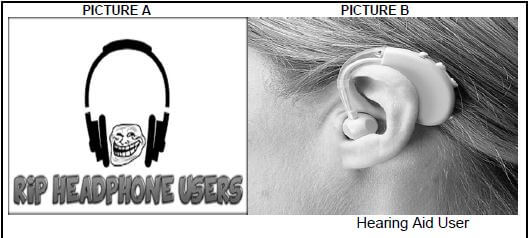 |
If you listen to loud music with headphones for a long time, you may suffer permanent hearing loss. It is important to control the volume levels – if not; you could be forced to exchange your headphones for a hearing aid. [Adapted from The Internet] |
1.14 What is the device in Picture B called? (1)
1.15 When do people normally use the abbreviation RIP? (1)
1.16 What is the difference between the 2001 census and the one done in 2011? (2)
1.17 It is a good idea to listen to loud music with headphones. Discuss your view. (2)
TOTAL SECTION A: 30
SECTION B: SUMMARY
QUESTION 2
Preparing for your Grade 12 final examination is important.
Read TEXT C below and list SEVEN tips on how to prepare for your final examinations.
INSTRUCTIONS
- Your summary must be written in point form.
- List your SEVEN points in full sentences using no more than 70 words.
- Number your sentences from 1 to 7.
- Write only ONE point per sentence.
- Use your OWN words as far as possible.
- Indicate the number of words you have used in brackets at the end of your summary.
TEXT C
TIPS FOR FINAL EXAMINATIONS With your finals looming on the horizon, you should be thinking about studying and revision. It can be difficult because everyone is different. There is no magical study method that works for everyone. There are, however, plenty of techniques. Find one that works for you. [Adapted from www.careersportal.co.za] |
TOTAL SECTION B: 10
SECTION C: LANGUAGE
QUESTION 3: ANALYSING AN ADVERTISEMENT
Study the advertisement (TEXT D) below and answer the set questions.
TEXT D 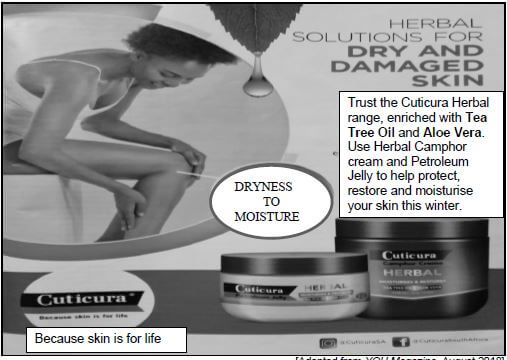
[Adapted from YOU Magazine, August 2018]
3.1 Identify the slogan of the advertisement. (1)
3.2 To whom would this advertisement appeal? (1)
3.3 State THREE benefits of using this product. (3)
3.4 How do you know that this product contains natural ingredients? (2)
3.5 Choose the correct answer to complete the following sentence:
The word ‘trust’ in the advertisement guarantees that …
- the product is affordable.
- men cannot use the product.
- the product definitely works.
- the product does not work. (1)
3.6 Do you think the picture of the girl supports the message of the advertisement? (2) [10]
QUESTION 4: ANALYSING A CARTOON
TEXT E 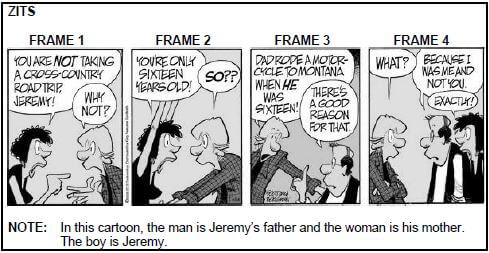
4.1 Refer to FRAME 1:
4.1.1 Choose the correct answer to complete the following sentence: Jeremy’s question indicates that he feels his mother is …
- unpredictable.
- understanding.
- unreasonable.
- inconsiderate. (1)
4.1.2 Which word is used to show that Jeremy’s mother is strongly against him going on the road trip? (1)
4.2 Which TWO visual clues in FRAME 2 show that Jeremy’s mother is angry at him? (2)
4.3 The cartoonist uses verbal clues in FRAME 2 to emphasise Jeremy’s reaction to his mother’s response. Mention TWO. (2)
4.4 Why does Jeremy’s mother disagree with him going on a road trip? (1)
4.5 Rewrite the following as a full sentence. ‘Because I was me and not you.’ (Frame 4) (1)
4.6 Do you think that Jeremy’s parents are justified in refusing to let him go on a road trip? Give a reason for your answer. (2) [10]
QUESTION 5: LANGUAGE AND EDITING SKILLS
5.1 Read the following passage (TEXT F), which contains some deliberate errors, and answer the set questions.
TEXT F
THE POWER OF GRATITUDE
[Adapted from Your Family, December 2018] |
5.1.1 Correct the SINGLE error in each of the following sentences. Write down ONLY the question number and the words you have corrected.
- Gratitude is much more then just saying please and thank you. (1)
- It is something you feel – a loving and positive respond acknowledging the things and people we are lucky enough to experience. (1)
- Every child are taught to say please and thank you from a young age, but the understanding that comes with being thankful takes more time to develop. (1)
- Studies suggest that grateful teenagers are much satisfied with their lives. (1)
5.1.2 Complete the following tag question. Write down ONLY the missing words. Grateful teenagers also tend to support others emotionally, ... ...? (1)
5.1.3 Study the following sentence and state the part of speech of the underlined words.
Acknowledge and talk about people who have dedicated themselves to a greater good, whether they are well-known figures like Nelson Mandela, or people who do good everyday like firefighters and social workers. (2)
5.1.4 Rewrite the following sentence in the negative form: A parent has to set the example by saying please and thank you. (1)
5.1.5 Rewrite the following sentence in the past continuous tense: Children can express gratitude as a routine while having dinner. (1)
5.1.6 Rewrite the following sentence in reported speech: Amy said, ‘Gratitude is a powerful catalyst for happiness and the spark that lights up my life.’ (4)
5.1.7 Provide the correct degree of comparison in the following sentence: Showing gratitude is (important) than material possessions. (1)
5.2 Study the text (TEXT G) below and answer the set questions.
TEXT G 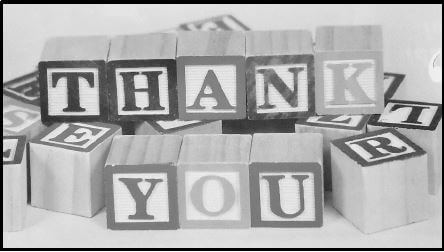
[Source: Your Family December 2018]
5.2.1 Rewrite the following sentence in the passive voice: Emphasise the value of showing gratitude. (1)
5.2.2 Provide a homophone for the underlined word: Children should be allowed to express thoughtfulness by donating clothes to the less fortunate. (1)
5.2.3 Rewrite the following sentence correcting the punctuation: Showing gratitude has a positive influence on peoples friendships. (1)
5.2.4 Rewrite the following sentence in the plural form: It is a good idea for us to start a gratitude journal. (1)
5.2.5 Provide the correct form of the word in brackets: Gratitude means we are ready to show (appreciate) for kindness. (1)
5.2.6 Combine the following sentences into a single sentence by using the words ‘either…or’
Start with: Either…
You can express gratitude by writing a thank you letter.
You can express gratitude by buying a gift. (1) [20]
TOTAL SECTION C: 40
GRAND TOTAL: 80
Civil Technology Civil Services Grade 12 Memorandum - NSC Exams Past Papers and Memos September 2019 Preparatory Examinations
MEMORANDUM
QUESTION 1: SAFETY, OHSA AND MATERIALS (GENERIC)
1.1 3 m (1)
1.2 (1) By means of a chute or (2) conveyor belt (2)
1.3 Similar answer:
- (1) Prevents unauthorised entry and (2) to protect the public (2)
1.4
1.4.1
- 30°
- 50° (2)
1.4.2
- 760 x 560 mm
3,7 m (2)
1.5
- 1 : 4 = 2 m = 0,5 m (one meter horizontal to four metres vertical) (2)
4
1.6 (1) Not further than 2/3 (2) of the extension length (2)
1.7 (1) The coating of a metal by means of electrolysis (2) with a thin layer of another metal (2)
1.8 Any THREE advantages of electroplating metals:
- Protects against corrosion
- Improves the engineering and mechanical properties of metal
- Increases the thickness of metal
- Resistant against wear and tear (3 x 1) (3)
1.9 Any TWO advantages of galvanising metals:
- Adds strength to the metal
- Increases the thickness of metal
- Prevents staining
- Protects against corrosion (2 x 1) (2) [20]
QUESTION 2: GRAPHICS, JOINING AND EQUIPMENT (GENERIC)
2.1
2.1.1 False (1)
2.1.2 True (1)
2.1.3 True (1)
2.1.4 True (1)
2.1.5 False (1)
2.2 FIGURE 2.2 on ANSWER SHEET A:
2.2.1 Outside door at 2.2.A (2)
2.2.2 Window at 2.2.B (2)
2.2.3 Water closet at 2.2.C (2)
2.2.4 Washbasin at 2.2.D (2)
2.2.5 Single sink unit at 2.2.E (2)
2.2.6 One-way switch single pole at 2.2.F (2)
2.2.7 Fluorescent light at 2.2.G (2)
2.2.8 Socket outlet at 2.2.H (2)
2.2.9 Grease trap at 2.2.I (2)
2.2.10 Wall-mounted light at 2.2.J (2)
2.3
2.3.1 Trim hexagon
2.3.2 Hex flange
2.3.3 Square shoulder screws (3)
2.4
2.4.1 Dumpy level (1)
2.4.2 Any ONE use of this instrument:
- Determine the difference in levels
- Determine levels and slopes
- Setting out buildings
- Transferring levels and heights (1 x 1) (1)
2.4.3
- – Focussing knob
- – Eye piece
- – Foot piece
- – Objective (4 x 1) (4)
2.4.4 (1) To obtain a level / horizontal (2) sight line / reading (2)
2.5 (1) If the moisture inside the level freezes and later reaches normal operating temperature, the moisture can condense (2) inside the tool, where it may damage the circuit board (2)
2.6
- M08 = Thread diameter
- 25 = Thickness (2) [40]
TOTAL SECTION A: 60
QUESTION 3: SAFETY, MATERIAL AND CONSTRUCTION (SPECIFIC)
3.1 Displace dangerous fumes/gases (1)
3.2 Similar answer:
- (1) Worker not fall (2) into opening / in emergency to pull worker out (2)
3.3
3.3.1 Rope grab
3.3.2 Locking snap hook
3.3.3 D-clip (3)
3.4 Zink is a (1) weak atomic bond (2) relative to other metals which during (3) dezincification (when zinc is removed from an alloy) (4) a weak deposit of porous/nobler/copper-rich metal will remain (4)
3.5 Water with an acid content (1)
3.6
3.6.1 Electrode (1)
3.6.2 Boundary (1)
3.6.3 Electrolyte (1)
3.6.4 Passive (1)
3.7 FIGURE 3.7 on ANSWER SHEET B shows layer 1 of a double return angle in a one-brick wall in stretcher bond. Draw the alternate layer of the one-brick wall on scale 1 : 10 on ANSWER SHEET B. (10)
3.8 Any TWO positions where manholes must be placed:
- Before municipal connection
- Every 20–25 m on a straight drain line
- Change of direction
- Change of gradient
- Change of level
- Important junctions (2 x 1) (2)
3.9
3.9.1 False (1)
3.9.2 True (1)
3.9.3 True (1) [30]
QUESTION 4: COLD-WATER SUPPLY, HOT-WATER SUPPLY AND EQUIPMENT (SPECIFIC)
4.1 (1) A fan turns a series of gears (2) that turn the meter dial and register the amount of water used (2)
4.2
4.2.1 Stopcock (1)
4.2.2
- – Spindle
- – Gland nut
- – Jumper
- – Compression fitting
- – Washer (5)
4.2.3 G (1)
4.2.4 Any TWO positions where this type of tap can be installed.
- Water service point
- Water supply pipes to water closet cisterns
- Regulating taps at showers (2 x 1) (2)
4.3 Water-saving attachment (1)
4.4 Cut off water supply (1)
4.5 (1) Polluted water / sand particles (2) affects mechanisms of valves and taps (2)
4.6 (1) When water heats up, (2) it rises (2)
4.7
4.7.1 D (1)
4.7.2 E (1)
4.7.3 G (1)
4.7.4 B (1)
4.7.5 C (1)
4.8
4.8.1 (1) At least 1 m away (2) from the geyser (2)
4.8.2 (1) Must be supported by roof trusses (2) and have at least two legs (2)
4.9 Direct solar hot-water system on ANSWER SHEET B
4.9.1 Draw the pressure-relief valve, non-return valve and pressure-reducing valve symbols in the correct openings marked 4.9, in the pipe system. (6)
4.9.2 Draw the hot-water pipe system from the solar panels to the storage tank. (5)
4.10 Any THREE caring measures which are applicable to the pipe-thread cutting machine.
- Maintain tools
- Keep cutting tools sharp and clean
- Check for misalignment of moving parts
- Use only accessories that are recommended by the manufacturer (3 x 1) (3) [40]
QUESTION 5: DRAINAGE, SANITARY FITMENTS AND QUANTITIES (SPECIFIC)
5.1
5.1.1 Soil water. (1) Contains organic contaminants/human excretions (2) from water closet/urinals (2)
5.1.2 Waste water. (1) Water discharged from (2) sink / washbasin / hand basin / shower / bath (2)
5.2 Any similar answer:
- (1) The water be able to convey solids (2) for adequate flushing of the system/ the system not be blocked (2)
5.3
5.3.1 Socket-and-spigot joint (1)
5.3.2 Ring seal (1)
5.2.3 Keeps out aggressive groundwater/sandy soil and tree roots (1)
5.4 Fully describe the cause of a siphonic action in a drain system.
- (1) When waste water is suddenly (2) discharged from sanitary fixtures on (3) the upper floor, (4) it moves rapidly through the soil pipes. (5) It may suck some air from the lateral branch pipe, (6) resulting in the flow of the water from the trap. (6)
5.5
5.1.1 True (1)
5.1.2 True (1)
5.1.3 False (1)
5.1.4 True (1)
5.6 (1) Remove visible blockages. (2) Fill the sink with 3–4 cm of water. (3) Place the plunger over the opening and push down hard. (3)
5.7 Any TWO properties:
- Durable / strong
- Pleasant, glazed surface
- Different colours (2 x 1) (2)
5.8
5.8.1
- – Inspection eye
- – Soil-water pipe
- – Pipe bend
- – Gully
- – Trap (5)
5.8.2 Cleaning / Removing blockages (1)
5.8.3 40 / 50 mm (1)
5.9
5.9.1 2 (1)
5.9.2 1,3 m + 1,3 m = 2,6 m (2 600 mm) (2)
5.9.3 12 m (12 000 mm) (1)
5.9.4 2 (1)
5.10
5.10.1
- The volume of the tank in m³.
πr²h = 22 x 0,9 x 0,9 x 2,8 = 7,128 m³ (3)
7
5.10.2 The volume of water that the tank can hold. (1)
- 7,13 m³ x 1 000 = 7 128 ℓ [40]
QUESTION 6: GRAPHICS AS A MEANS OF COMMUNICATION, ROOFWORK, STORM WATER AND JOINING (SPECIFIC)
6.1 FIGURE 6.1 on ANSWER SHEET C shows the top and front elevations of a cylindrical pipe with a 45° cut-off.
Draw the development of the pipe on ANSWER SHEET C.
Show all construction lines. (21)
6.2 1 m (1)
6.3 (1) Water proofing of roofs (2) at junctions / where walls protrude above the roof (2)
6.4 Channel water away from the house (1)
6.5
6.5.1 True (1)
6.5.2 False (1)
6.5.3 True (1)
6.6 Any TWO:
- Manufactured from pine-tree bark
- Looks like gum
- Not water soluble
- Dissolves in spirits
- Low melting point
- Inflammable when heated to boiling point
- Soldering brass, copper, tin and lead (2 x 1) (2) [30]
TOTAL: 200
ANSWER SHEET A | CIVIL TECHNOLOGY GENERIC | NAME: |
2.2 Use the information on ANSWER SHEET A and complete the floor plan to scale 1 : 100. 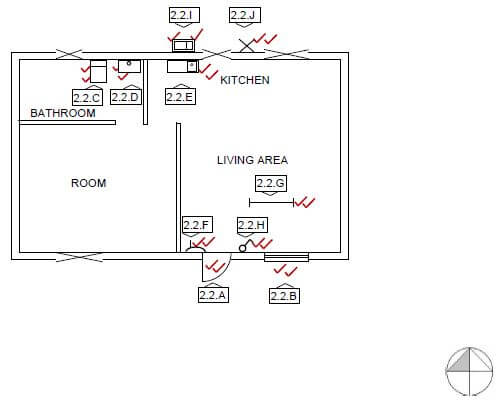
Outside door at 2.2.A | 2 | |
Window at 2.2.B | 2 | |
Water closet at 2.2.C | 2 | |
Wash basin at 2.2.D | 2 | |
Single sink unit at 2.2.E | 2 | |
One-way switch-single pole at 2.2.F | 2 | |
Fluorescent light at 2.2.G | 2 | |
Socket outlet at 2.2.H | 2 | |
Grease trap at 2.2.I | 2 | |
Wall-mounted light at 2.2.J TOTAL: 20 | 2 | |
ANSWER SHEET B | CIVIL TECHNOLOGY CIVIL SERVICES | NAME: |
3.7 FIGURE 3.7 on ANSWER SHEET B shows layer 1 of a double return angle in a one-brick wall in stretcher bond. Draw the alternate layer of the one brick wall on scale 1 : 10 on ANSWER SHEET B. (10) 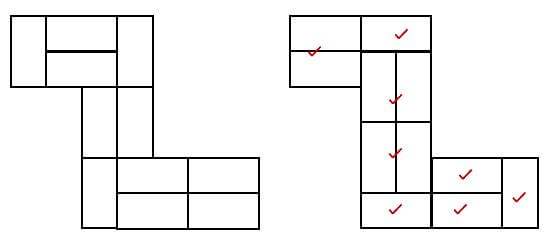
Brickwork | 8 | |
Application of scale | 2 | |
TOTAL: 10 |
4.9 Complete the diagrammic representation of a pumped direct solar hot-water system on ANSWER SHEET B by drawing in the following parts: 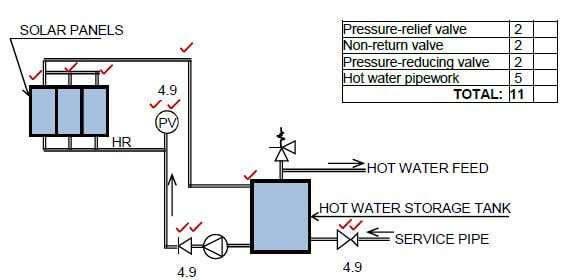
ANSWER SHEET C | CIVIL TECHNOLOGY CIVIL SERVICES | NAME: |
6.1 FIGURE 6.1 on ANSWER SHEET C shows the top and front elevations of a cylindrical pipe with a 45° cut-off.
Draw the development of the pipe on ANSWER SHEET C.
Show all construction lines. (21) . 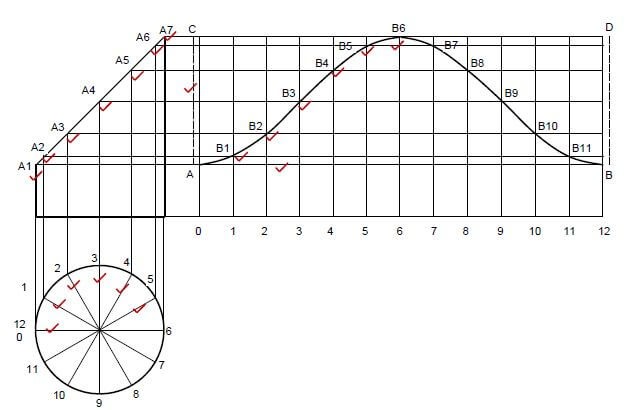
Base line A-B | 1 | |
Seam lines A-C and B-D | 1 | |
Dividing lines 0-12 on top view | 6 | |
Vertical and horizontal construction lines A1–A7 | 7 | |
Intersection points and development lines B1–B11 6 | ||
TOTAL: 21 |
Civil Technology Civil Services Grade 12 Questions - NSC Exams Past Papers and Memos September 2019 Preparatory Examinations
REQUIREMENTS:
- ANSWER BOOK
- Drawing instruments
- A non-programmable pocket calculator
INSTRUCTIONS AND INFORMATION
- This question paper consists of SIX questions: TWO questions are generic and FOUR questions are subject specific.
- Answer ALL the questions.
- Answer each question as a whole. Do NOT separate subsections of questions.
- Start the answer to EACH question on a NEW page.
- Do NOT write in the margins of the ANSWER BOOK.
- You may use sketches to illustrate your answers.
- Write ALL calculations and answers in the ANSWER BOOK or on the attached ANSWER SHEETS.
- Use the mark allocation as a guide to the length of your answers.
- Make drawings and sketches in pencil, fully dimensioned and neatly finished off with descriptive titles and notes to conform to the SANS/SABS Code of Practice for Building Drawings.
- For the purpose of this question paper, the size of a brick should be taken as 220 mm x 110 mm x 75 mm
- Use your own discretion where dimensions and/or details have been omitted.
- Answer QUESTIONS 2.2, 3.7, 4.9 and 6.1 on the attached ANSWER SHEETS using drawing instruments where necessary.
- Write your NAME on every ANSWER SHEET and hand them in with your ANSWER BOOK, whether you have answered the question or not.
- Due to electronic transfer, drawings in the question paper are NOT to scale.
QUESTIONS
QUESTION 1: SAFETY, OHSA AND MATERIALS (GENERIC)
Start the question on a NEW page.
1.1 What is the maximum height of a trestle scaffold? (1)
1.2 Building rubble should never be dropped from elevated areas. Name the correct method of disposing rubble from elevated areas. (2)
1.3 Briefly motivate why a construction site must be suitably cordoned off. (2)
1.4 Choose the correct answer from those in brackets with regards to the construction process of stairs:
1.4.1 Stairways must be installed at least (30° / 25°) from the horizontal platform and not more than (45° / 50°) from a wall. (2)
1.4.2 Stairways that will not be a permanent part of the building construction must have landings of at least (760 x 560 mm / 750 x 600 mm) for every (3,7 m / 2,5 m) or less vertical rise. (2)
1.5 FIGURE 1.5 shows a ladder that is placed against a wall. What is the correct measurement at A to keep it stable? Show or indicate how to achieve the ratio. (2) 
FIGURE 1.5
1.6 Explain the safety requirements when extending a ladder. (2)
1.7 Briefly explain the electroplating process of metals. (2)
1.8 Name THREE advantages of electroplating metals. (3 x 1) (3)
1.9 Name TWO advantages of galvanising metals. (2 x 1) (2) [20]
QUESTION 2: GRAPHICS, JOINING AND EQUIPMENT (GENERIC)
Start this question on a NEW page.
2.1 Indicate if the following statements, regarding site plans, are TRUE or FALSE. Write only ‘true’ or ‘false’ next to the question number in your ANSWER BOOK.
2.1.1 Scale 1 : 10 is used (1)
2.1.2 Ground contours are shown (1)
2.1.3 Layout of sewage is shown (1)
2.1.4 The proposed work is indicated in red (1)
2.1.5 Floor finishes of rooms are indicated (1)
2.2 FIGURE 2.2 on ANSWER SHEET A shows an incomplete floorplan of a flat to scale 1 : 100. Complete the floorplan by using the following information:
2.2.1 Outside door at 2.2.A (2)
2.2.2 Window at 2.2.B (2)
2.2.3 Water closet at 2.2.C (2)
2.2.4 Washbasin at 2.2.D (2)
2.2.5 Wash tub at 2.2.E (2)
2.2.6 One-way switch single pole at 2.2.F (2)
2.2.7 Fluorescent light at 2.2.G (2)
2.2.8 Socket outlet at 2.2.H (2)
2.2.9 Grease trap at 2.2.I (2)
2.2.10 Wall-mounted light at 2.2.J (2)
2.3 Identify the different types of bolts in FIGURES 2.3.1, 2.3.2 and 2.3.3.  (3)
(3)
2.4 Answer the following questions on the tool in FIGURE 2.4. 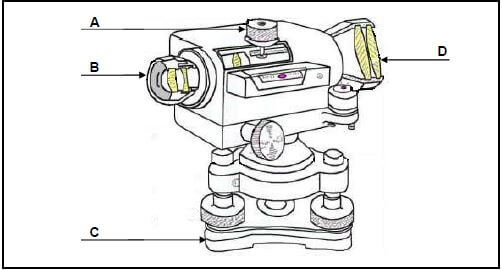
FIGURE 2.4
2.4.1 Identify the tool in FIGURE 2.4. (1)
2.4.2 Name ONE use of this tool. (1 x 1) (1)
2.4.3 Name the different parts A–D. (4 x 1) (4)
2.4.4 Name TWO uses of a laser level. (2)
2.5 Explain why the laser level should not be stored in extremely cold areas. Refer to the moisture inside the tool. (2)
2.6 Explain the meaning of the following code for Rawl bolts: M08/25. (2) [40]
TOTAL SECTION A: 60
QUESTION 3: SAFETY, MATERIAL AND CONSTRUCTION (SPECIFIC)
Start this question on a NEW page.
3.1 What is the purpose of an extractor fan when working in manholes? (1)
3.2 Briefly motivate why a person entering a manhole must wear a safety harness. (2)
3.3 Identify the safety harness appliances in FIGURES 3.3.1 to 3.3.3.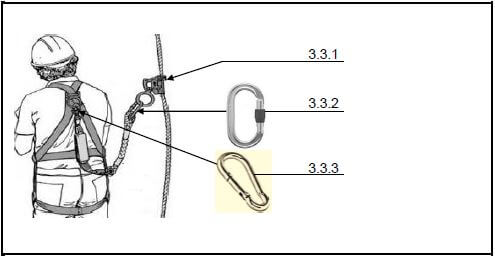 (3)
(3)
3.4 Fully motivate why zinc is seen as a highly reactive metal. (4)
3.5 What type of water causes chemical corrosion in copper? (1)
3.6 Complete the following descriptions of the factors that determine galvanic corrosion through thermodynamic and kinetic conditions:
- The difference between the 3.6.1 potential of the two metals. (1)
- Contact resistance at the 3.6.2 between the two metals. (1)
- Electrical resistance of the 3.6.3 solution. (1)
- The presence of a 3.6.4 film. (1)
3.7 FIGURE 3.7 on ANSWER SHEET B shows layer 1 of a double return angle in a one-brick wall in stretcher bond. Draw the alternate layer of the one-brick wall to scale 1 : 10 on ANSWER SHEET B. (10)
3.8 Name TWO positions in a drainage system where manholes must be placed. (2 x 1) (2)
3.9 Indicate whether the following statements are TRUE or FALSE. Write only ‘true’ or ‘false’ next to the number in the ANSWER BOOK.
3.9.1 The gradient for a Ø 100 mm drain pipe is 1 : 20. (1)
3.9.2 The temporary timber support structures that are placed to prevent excavations from caving in, are called shoring. (1)
3.9.3 The high-pressure jetting method to compact backfill material of drain trenches is only recommended for sandy soil. (1) [30]
QUESTION 4: COLD-WATER SUPPLY, HOT-WATER SUPPLY AND EQUIPMENT (SPECIFIC)
Start this question on a NEW page.
4.1 Briefly describe the working of a water meter which allows it to determine the amount of water used. (2)
4.2 Answer the following questions with regard to the tap in FIGURE 4.2. 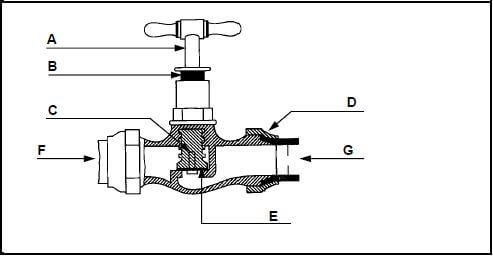
FIGURE 4.2
4.2.1 What is this type of tap called? (1)
4.2.2 Name the parts A–E. (5)
4.2.3 Which letter, F or G, indicates the flow direction of the water? (1)
4.2.4 Name TWO positions where this type of tap can be installed. (2 x 1) (2)
4.3 What is the purpose of the aerator which is installed at the end of a tap? (1)
4.4 What is the first step to be followed when water supply pipes are repaired? (1)
4.5 Briefly motivate why the water supply pipes which have to be repaired, should be free of sand particles before they are joined. (2)
4.6 Briefly motivate why the cold-water inlet is at the bottom and the hot-water outlet at the top of a high-pressure geyser. (2)
4.7 Choose a description with regard to a high-pressure geyser from COLUMN B that matches the correct item in COLUMN A. Write only the correct letter (A–G) next to the question number (4.7.1–4.7.5) in the ANSWER BOOK, for example, 4.7.6 H.
| COLUMN A | COLUMN B |
4.7.1 Drip tray |
|
(5)
4.8 Describe the following regulations which are applicable to geysers:
4.8.1 The position of the electric isolator switch (2)
4.8.2 The weight of the geyser when it is installed (2)
4.9 Complete the diagrammatic representation of a pumped direct solar hot-water system on ANSWER SHEET B, by drawing in the following parts:
4.9.1 Draw the pressure-relief valve, non-return valve and pressure-reducing valve symbols in the correct openings marked 4.9 in the pipe system. (6)
4.9.2 Draw the hot-water pipe system from the solar panels to the storage tank. (5)
4.10 Name THREE maintenance measures which are applicable to the pipe-thread cutting machine. (3 x 1) (3) [40]
QUESTION 5: DRAINAGE, SANITARY FITMENTS AND QUANTITIES (SPECIFIC)
Start this question on a NEW page.
5.1 Define the following terms:
5.1.1 Soil water (2)
5.1.2 Waste water (2)
5.2 Briefly motivate why sufficient volumes of water must be discharged into a drain system. (2)
5.3 Answer the following questions with regard to the drain pipe joint in FIGURE 5.3. 
FIGURE 5.3
5.3.1 What is this type of joint called? (1)
5.3.2 What is part A called? (1)
5.3.3 What is the purpose of A? (1)
5.4 Fully describe the cause of a siphonic action in a drain system. (6)
5.5 Indicate whether the following statements are TRUE or FALSE. Write only ‘true’ or ‘false’ next to the number in the ANSWER BOOK.
5.5.1 An inspection chamber is not deeper than 750 mm. (1)
5.5.2 A manhole must not be installed further than 2 m from the boundary wall. (1)
5.5.3 A manhole ramp keeps the water lock in a drain system. (1)
5.5.4 A vacuum tank must be pumped out regularly. (1)
5.6 Briefly describe the method to remove a blockage in a sink soil-water pipe with a plunger. (3)
5.7 Name TWO properties of ceramic for the use of sanitary fitments. (2 x 1) (2)
5.8 Answer the following questions with regard to the sink installation in FIGURE 5.8. 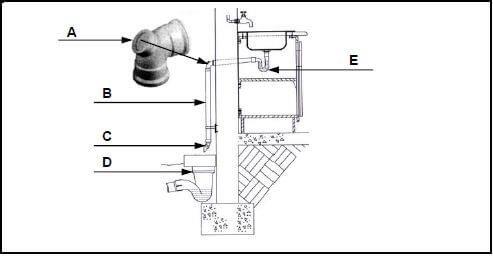
FIGURE 5.8
5.8.1 Identify the parts A–E. (5)
5.8.2 What is the purpose of part A? (1)
5.8.3 What is the sectional size of part B? (1)
5.9 FIGURE 5.9 shows the drain lay-out, to scale 1 : 100, of a building with a length of 6 000 mm and width of 3 000 mm. Determine the following quantities for the drain system. 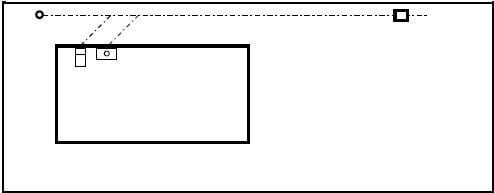
FIGURE 5.9
5.9.1 The number of fixed sanitary fitments needed (1)
5.9.2 The total length of branch pipes needed (2)
5.9.3 The total length of sewer pipes needed (1)
5.9.4 The number of access openings which must be installed (1)
5.10 A cylindrical water supply tank is 2 800 mm high and has a diameter of 1 800 mm. Determine the following: (Show all calculations and formulae)
5.10.1 The volume of the tank in m³ (3)
5.10.2 The volume of water that the tank can hold (1) [40]
QUESTION 6: GRAPHICS AS A MEANS OF COMMUNICATION, ROOFWORK, STORM WATER AND JOINING (SPECIFIC)
Start this question on a NEW page.
6.1 FIGURE 6.1 on ANSWER SHEET C shows the top and front elevations of a cylindrical pipe with a 45° cut-off. Draw the development of the pipe on ANSWER SHEET C. Show all construction lines. (21)
6.2 What is the maximum spacing of the gutter brackets for galvanised mild steel gutters? (1)
6.3 Briefly describe the purpose of flashings in roof construction. (2)
6.4 What is the purpose of the concrete shoe underneath the gutter downpipe? (1)
6.5 Indicate whether the following statements are TRUE or FALSE. Write only ‘true’ or ‘false’ next to the number in the ANSWER BOOK.
6.5.1 The municipality is responsible for all public stormwater systems. (1)
6.5.2 Stormwater must be directed into sewage systems. (1)
6.5.3 Chemicals may not be directed into stormwater systems. (1)
6.6 Name TWO properties of resin flux for soldering work. (2 x 1) (2) [30]
TOTAL: 200
ANSWER SHEET A | CIVIL TECHNOLOGY GENERIC | NAME: |
2.2 Use the information on ANSWER SHEET A and complete the floorplan to scale 1 : 100. 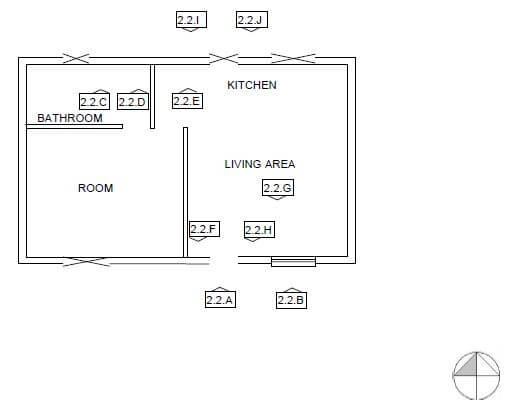
Outside door at 2.2.A | 2 | |
Window at 2.2.B | 2 | |
Water closet at 2.2.C | 2 | |
Washbasin at 2.2.D | 2 | |
Sink unit at 2.2.E | 2 | |
One-way switch-single pole 2.2.F | 2 | |
Fluorescent light at 2.2.G | 2 | |
Socket outlet at 2.2.H | 2 | |
Grease trap at 2.2.I | 2 | |
Wall-mounted light at 2.2.J | 2 | |
TOTAL: | 20 |
ANSWER SHEET B | CIVIL TECHNOLOGY CIVIL SERVICES | NAME: |
3.7 FIGURE 3.7 on ANSWER SHEET B shows layer 1 of a double return angle in a one-brick wall in stretcher bond. Draw the alternate layer of the one brick wall to scale 1 : 10 on ANSWER SHEET B. (10) 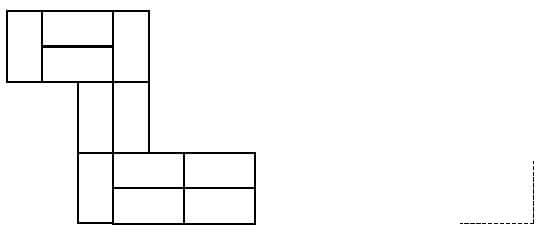
Brickwork | 8 | |
Application of scale | 2 | |
TOTAL: | 10 |
4.9 Complete the diagrammatic representation of a pumped direct solar hot-water system on ANSWER SHEET B, by drawing in the following parts: 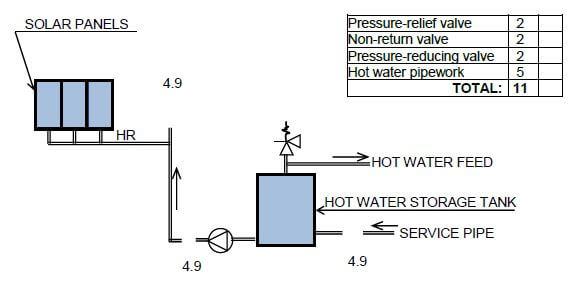
Pressure-relief valve | 2 | |
Non-return valve | 2 | |
Pressure-reducing valve | 2 | |
Hot water pipework | 5 | |
TOTAL: | 11 |
ANSWER SHEET C | CIVIL TECHNOLOGY CIVIL SERVICES | NAME: |
6.1 FIGURE 6.1 on ANSWER SHEET C shows the top and front elevations of a cylindrical pipe with a 45° cut-off.
Draw the development of the pipe on ANSWER SHEET C. Show all construction lines. (21) . 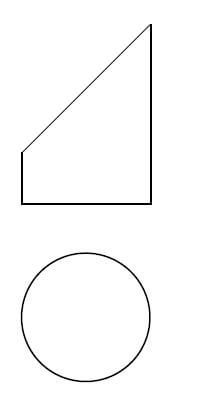
Base line A-B | 1 | |
Seam lines A-C and B-D | 1 | |
Dividing lines 0-12 on top view | 6 | |
Vertical and horizontal construction lines A1-A7 | 7 | |
Intersection points and development lines B1-B11 | 6 | |
TOTAL: | 21 |
Civil Technology Woodworking Grade 12 Questions - NSC Exams Past Papers and Memos September 2019 Preparatory Examinations
REQUIREMENTS:
- ANSWER BOOK
- Drawing instruments
- A non-programmable pocket calculator
INSTRUCTIONS AND INFORMATION
- This question paper consists of SIX questions: TWO questions are generic and FOUR questions are subject specific.
- Answer ALL the questions.
- Answer each question as a whole. Do NOT separate subsections of questions.
- Start the answer to EACH question on a NEW page.
- Do NOT write in the margins of the ANSWER BOOK.
- You may use sketches to illustrate your answers.
- Write ALL calculations and answers in the ANSWER BOOK or on the attached ANSWER SHEETS.
- Use the mark allocation as a guide to the length of your answers.
- Make drawings and sketches in pencil, fully dimensioned and neatly finished off with descriptive titles and notes to conform to the SANS/SABS Code of Practice for Building Drawings.
- For the purpose of this question paper, the size of a brick should be taken as 220 mm x 110 mm x 75 mm.
- Use your own discretion where dimensions and/or details have been omitted.
- Answer QUESTIONS 2.2, 4.5 and 6.5 on the attached ANSWER SHEETS using drawing instruments where necessary.
- Write your NAME on every ANSWER SHEET and hand them in with your ANSWER BOOK, whether you have answered the question or not.
- Due to electronic transfer, drawings in the question paper are NOT to scale.
QUESTION
QUESTION 1: SAFETY OHSA AND MATERIALS (GENERIC)
Start this question on a NEW page.
1.1 What is the maximum height of a trestle scaffold? (1)
1.2 Building rubble should never be dropped from elevated areas. Name the correct method of disposing rubble from elevated areas. (2)
1.3 Briefly motivate why a construction site must be suitably cordoned off. (2)
1.4 Choose the correct answer from those in brackets with regards to the construction process of stairs:
1.4.1 Stairways must be installed at least (30° / 25°) from the horizontal platform and not more then (45° / 50°) from a wall. (2)
1.4.2 Stairways that will not be a permanent part of the building construction must have landings of at least (760 x 560 mm / 750 x 600 mm) for every (3,7 m / 2,5 m) or less vertical rise. (2)
1.5 FIGURE 1.5 shows a ladder that is placed against a wall. What is the correct measurement at 1.5.A to keep it stable? Show or indicate how to achieve the ratio. 
FIGURE 1.5 (2)
1.6 Explain the safety requirements when extending a ladder. (2)
1.7 Briefly explain the electroplating process of metals. (2)
1.8 Name THREE advantages of electroplating metals. (3 x 1) (3)
1.9 Name TWO advantages of galvanising metals. (2 x 1) (2) [20]
QUESTION 2: GRAPHIC COMMUNICATING, JOINING AND EQUIPMENT (GENERIC)
Start this question on a NEW page.
2.1 Indicate if the following statements, regarding site plans, are TRUE or FALSE. Write only ‘true’ or ‘false’ next to the question number in your ANSWER BOOK.
2.1.1 Scale 1 : 10 is used (1)
2.1.2 Ground contours are shown (1)
2.1.3 Layout of sewage is shown (1)
2.1.4 The proposed work is indicated in red (1)
2.1.5 Floor finishes of rooms are indicated (1)
2.2 FIGURE 2.2 on ANSWER SHEET A shows an incomplete floorplan of a flat to scale 1 : 100. Complete the floorplan by using the following information:
2.2.1 Outside door at 2.2.A (2)
2.2.2 Window at 2.2.B (2)
2.2.3 Water closet at 2.2.C (2)
2.2.4 Washbasin at 2.2.D (2)
2.2.5 Wash tub at 2.2.E (2)
2.2.6 One-way switch single pole at 2.2.F (2)
2.2.7 Fluorescent light at 2.2.G (2)
2.2.8 Socket outlet at 2.2.H (2)
2.2.9 Grease trap at 2.2.I (2)
2.2.10 Wall-mounted light at 2.2.J (2)
2.3 Identify the different types of bolts in FIGURES 2.3.1, 2.3.2 and 2.3.3.  (3)
(3)
2.4 Answer the following questions on the tool in FIGURE 2.4. 
FIGURE 2.4
2.4.1 Identify the tool in FIGURE 2.4. (1)
2.4.2 Name ONE use of this tool. (1 x 1) (1)
2.4.3 Name the different parts A–D. (4 x 1) (4)
2.4.4 Name TWO uses of a laser level. (2)
2.5 Explain why the laser level should not be stored in extremely cold areas. Refer to the moisture inside the tool. (2)
2.6 Explain the meaning of the following code for Rawl bolts: M08/25. (2) [40]
TOTAL SECTION A: 60
QUESTION 3: CASEMENTS, CUPBOARDS, WALL-PANELLING AND QUANTITIES (SPECIFIC)
Start this question on a NEW page.
3.1 Give ONE word/term for EACH of the following descriptions by choosing a word/term from the list below. Write only the word/term next to the question numbers (3.1.1–3.1.3) in the ANSWER BOOK, e.g. 3.1.4 fanlight
| tilting batten; soffit; reveal; panel; rebate |
3.1.1 The area of the wall at the side of an opening that is at right angles to the general face of the wall around a door and window (1)
3.1.2 A batten fixed to the eaves end of a pitched roof to maintain the roof slope at the eaves course (1)
3.1.3 A groove or recess in woodwork to accommodate a panel or pane (1)
3.2 FIGURE 3.2 below shows the sectional view of a tongue and groove wall panel from the floor to the ceiling, fastened to a 110 mm thick wall. Study the drawing and answer the questions that follow. 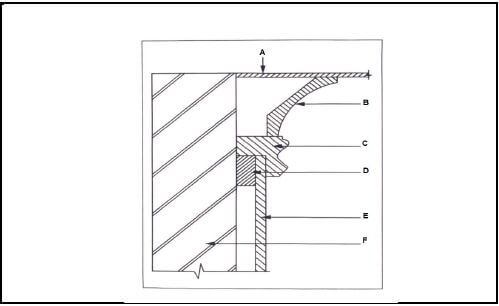
FIGURE 3.2
3.2.1 Identify parts A–E. (5)
3.2.2 What is the function of F? (2)
3.2.3 Give TWO reasons for panelling a wall. (2)
3.3 FIGURE 3.3 below shows the front and side elevation of a bedroom cupboard, without doors, fitted from floor to ceiling. An incomplete cutting list specifying some parts of the cupboard is given. Study the drawing and complete the cutting list by providing answers to 3.3.1–3.3.7. 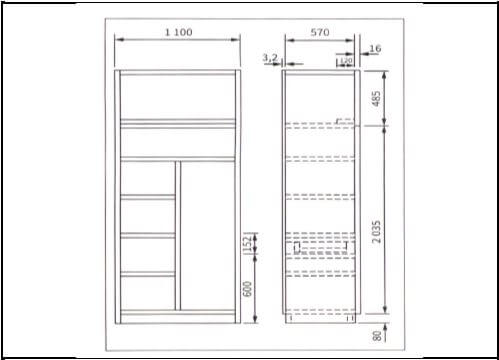
FIGURE 3.3
Parts | Quantity | Unit | Length | Width | Thickness | Total length | Material |
Sides | 3.3.1 | mm | 2 490 | 570 | 16 | 4 980 | Oak |
Rail | 1 | mm | 3.3.2 | 120 | 16 | 968 | Oak |
Top of top unit | 1 | mm | 968 | 3.3.3 | 16 | 968 | Oak |
Bottom unit | 1 | mm | 3.3.4 | 570 | 16 | 968 | Oak |
Shelving | 3 | mm | 570 | 492 | 16 | 3.3.5 | Oak |
Kick plate | 1 | mm | 968 | 3.3.6 | 16 | 968 | Oak |
Back | 1 | mm | 2 310 | 1100 | 3.3.7 | 2 310 | Oak |
(7)
3.4 FIGURE 3.4 below shows part of a double casement with fanlights. Study the picture and answer the questions that follow. 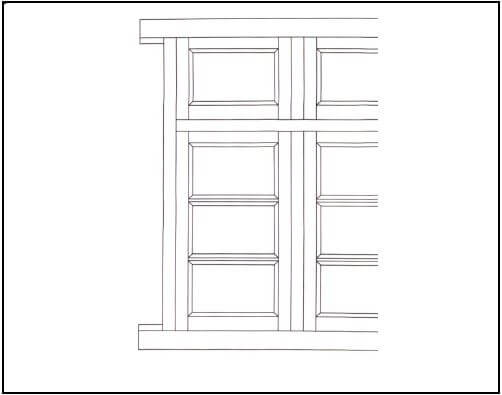
FIGURE 3.4
3.4.1 Name the THREE main parts of the double casement with fanlights. (3)
3.4.2 Discuss the purpose of a transom in a casement with fanlights. (3)
3.4.3 Discuss the advantages of fanlights in a casement. (3)
3.4.4 Define a casement window. (2) [30]
QUESTION 4: ROOFS, CEILINGS, TOOLS, EQUIPMENT AND MATERIALS (SPECIFIC)
Start this question on a NEW page.
4.1 FIGURE 4.1 below shows a joint-to-joint member/part of a door. Study the drawing and answer the questions that follow. 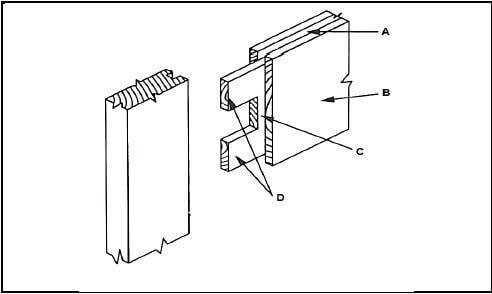
FIGURE 4.1
4.1.1 Identify the joint construction. (1)
4.1.2 Identify parts A–D. (4)
4.2 FIGURE 4.2 below shows two woodworking machines. Study the pictures and answer the questions that follow. 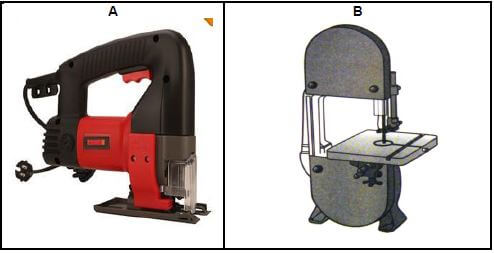
FIGURE 4.2
4.2.1 Identify machines A and B. (2)
4.2.2 Discuss how you will take care of machine B. (3)
4.2.3 Recommend TWO ways of storing A after use. (2)
4.3 Give TWO properties of roof tiles. (2)
4.4 Name the most common traditional type of profiled roofing that is used in South Africa. (1)
4.5 The migration of swallows from the north to the south in summer creates a big problem for home owners, because the birds build their nests in the eaves of roofs.
A closed eave overhang can solve this problem. Draw therefore on ANSWER SHEET B, to a scale of 1 : 10, a detailed sectional view of a closed eave overhang of a roof truss.
Show the following details in your drawing:
- Wall plate 114 mm x 38 mm
- Part of the 114 mm x 38 mm tie beam
- Part of the 114 mm x 38 mm rafter
- Roof pitch 30˚
- Beam filling
- Quarter round moulding 18 mm
- Purlins 76 mm x 50 mm
- Galvanised corrugated iron roof sheeting
- Covering material for the closing of the eaves (slats, soffit board, cement fibre board 6 mm)
- 225 mm x 30 mm fascia board
- 100 mm x 100 mm square gutter
- Downpipe 75 mm x 75 mm
- 500 mm eaves overhang (22)
4.6 Explain in your own words the difference between a hurricane clip and a gang nail (nail plate). (1)
4.7 Discuss the difference between the following:
4.7.1 Hipped roof (1)
4.7.2 Hipped roof with a valley (1) [40]
QUESTION 5: CENTERING, FORMWORK, SHORING AND GRAPHICS AS MEANS OF COMMUNICATION (SPECIFIC)
Start this question on a NEW page.
5.1 FIGURE 5.1 shows a sketch of a lock. Study the sketch and answer the questions that follow. 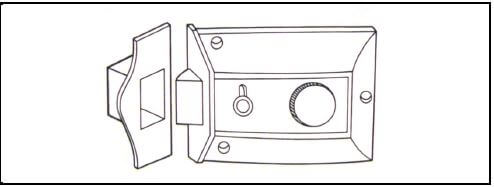
FIGURE 5.1
5.1.1 Identify the lock. (1)
5.1.2 Identify the part of the door into which the lock will be fitted. (1)
5.1.3 Name an entrance door were this lock can be fitted. (1)
5.1.4 Name the part of the lock that will be fitted into the frame of the door. (1)
5.1.5 Explain the difference between a keyhole and a lock. (2)
5.2 Explain ONE use of the following shores:
5.2.1 Double-flying shore (1)
5.2.2 Dead shore (1)
5.3 Describe the function of the following components of dead shore:
5.3.1 Sole plate (1)
5.3.2 Prop/Strut (1)
5.4 FIGURE 5.4 below shows a pictorial view of the construction detail underneath a centre of arch. Study the picture and answer the questions that follow. 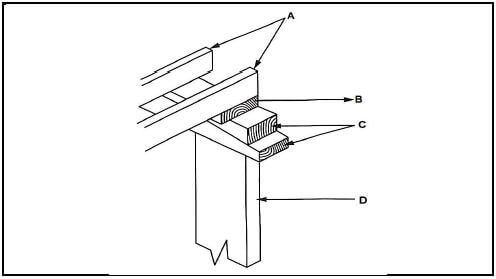
FIGURE 5.4
5.4.1 Identify parts A–D. (4)
5.4.2 Explain ONE use of A as shown in FIGURE 5.4. (1)
5.4.3 Explain TWO purposes of part C. (2)
5.4.4 Describe the function of D. (1)
5.5 Recommend any THREE wooden board products that can be used as sides for formwork. (3)
5.6 FIGURE 5.6 below shows a horizontal section of a square column.
Study FIGURE 5.6 and identify parts A–F. Write only the answer next to the letters (A–F) in the ANSWER BOOK. 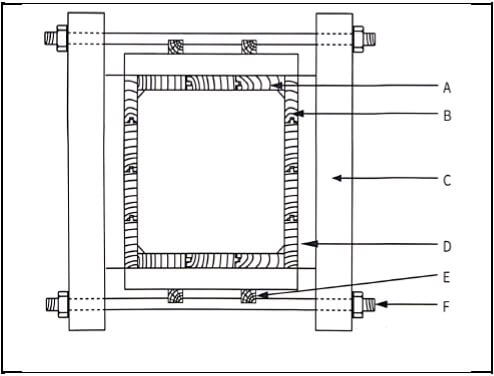
FIGURE 5.6 (6)
5.7 Explain the function of E. (2)
5.8 Explain the function of F. (1) [30]
QUESTION 6: SUSPENDED FLOORS, STAIRCASES, IRON MONGERY, DOORS AND JOINING (SPECIFIC)
Start this question on a NEW page.
6.1 FIGURE 6.1 below shows the floor plan of a straight flight of stairs with a landing. Study the picture and answer the questions that follow. 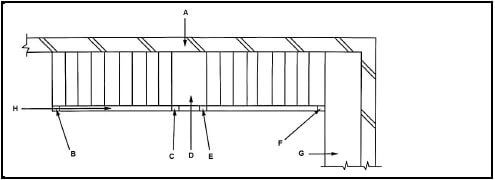
FIGURE 6.1
6.1.1 Identify parts A–H. (8)
6.1.2 Explain the purpose of a newel or newel post. (2)
6.1.3 Differentiate between stairs with a landing and stairs with a half-landing (4)
6.2 FIGURE 6.2 below shows the base of a dead shore. Study the picture and answer the questions that follow. 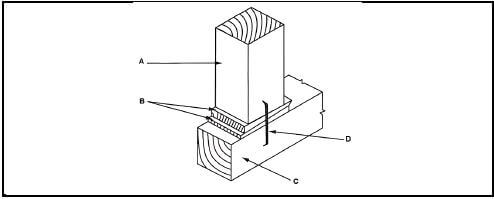
FIGURE 6.2
6.2.1 Explain in your own words the function of dead shore. (2)
6.2.2 Identify the parts marked A, B and C. (3)
6.2.3 Explain the purpose of part D. (1)
6.3 FIGURE 6.3 below shows the sectional view of a door. Study the drawing and answer the questions that follow. 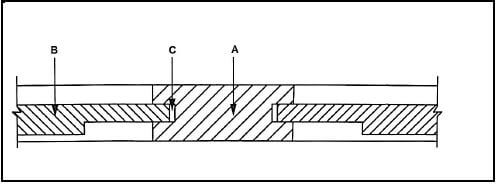
FIGURE 6.3
6.3.1 Identify parts A, B and C. (3)
6.3.2 Explain what is meant by the muntin of a door. (1)
6.3.3 Explain the purpose of opening C in FIGURE 6.3. (2)
6.4 Explain the difference between a batten and a purlin. (4)
6.5 Draw on ANSWER SHEET C the different methods that can be used to fix floor joists to walls. (10) [40]
TOTAL: 200
ANSWER SHEET A | CIVIL TECHNOLOGY GENERIC | NAME: |
2.2 Use the information on ANSWER SHEET A and complete the floorplan to scale 1 : 100. 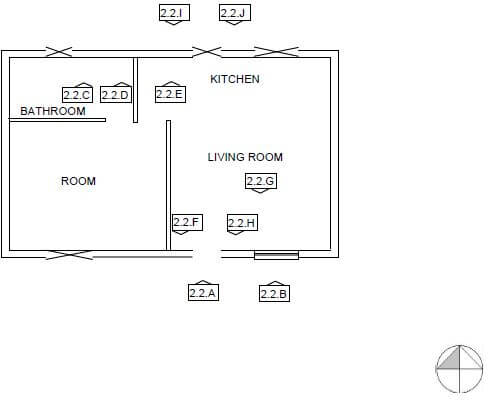
Outside door at 2.2.A | 2 | |
Window at 2.2.B | 2 | |
Water closet at 2.2.C | 2 | |
Washbasin at 2.2.D | 2 | |
Wash tub at 2.2.E | 2 | |
One-way switch-single pole at 2.2.F | 2 | |
Fluorescent light at 2.2.G | 2 | |
Socket outlet at 2.2.H | 2 | |
Grease trap at 2.2.I | 2 | |
Wall-mounted light at 2.2.J | 2 | |
TOTAL: 20 |
ANSWER SHEET B | CIVIL TECHNOLOGY WOODWORKING | NAME: |
4.5 Draw on ANSWER SHEET B to scale 1 : 10 a detailed sectional view of a closed (concealed) eave overhang of a roof truss. (22)
ASSESSMENT CRITERIA | MARKS | CANDIDATE'S MARKS | |
A | Corrugated iron sheeting/IBR sheeting | 1 | |
B | Rafter | 1 | |
C | Tie beam | 1 | |
D | Wall plate | 2 | |
E | Wall | 2 | |
F | Plaster | 2 | |
G | Downpipe | 2 | |
H | Quarter-round (moulding) | 1 | |
I | Soffit hanger | 2 | |
J | Soffit board | 2 | |
K | Gutter | 2 | |
L | Fascia board | 2 | |
M | Foot of purlin | 1 | |
N | Purlin | 1 | |
TOTAL: | 22 | ||
ANSWER SHEET C | CIVIL TECHNOLOGY WOODWORKING | NAME: |
6.5 Draw on ANSWER SHEET C the different methods that can be used to fix floor joists to walls. (10)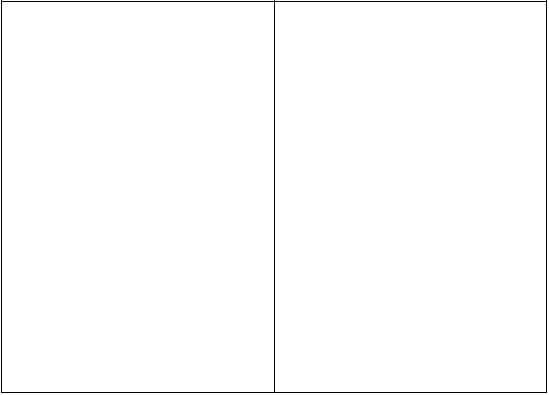
ASSESSMENT CRITERIA | MARKS | CANDIDATE'S MARKS |
Joist build into wall | 2 | |
Floor joist | 2 | |
Scale | 1 | |
Joist bolted to wall with truss hanger | 2 | |
Truss or joist hanger | 2 | |
Scale | 1 | |
TOTAL: | 10 |
Civil Technology Woodworking Grade 12 Memorandum - NSC Exams Past Papers and Memos September 2019 Preparatory Examinations
MEMORANDUM
QUESTION 1: SAFETY, OHSA AND MATERIAL (GENERIC)
1.1 3 m (1)
1.2 (1) By means of a chute or (2) conveyor belt (2)
1.3 Similar answer:
- (1) Prevents unauthorised entry and (2) to protect the public. (2)
1.4
1.4.1
- 30°
- 50° (2)
1.4.2
- 760 x 560 mm
3,7 m (2)
1.5
- 1 : 4 = 2 m = 0,5 m (one meter horizontal to four metres vertical) (2)
4
1.6 (1) Not further than 2/3 (2) of the extension length (2)
1.7 (1) The coating of a metal by means of electrolysis (2) with a thin layer of another metal. (2)
1.8 Any THREE advantages of electroplating of metals:
- Protects against corrosion
- Improves the engineering and mechanical properties of metal
- Increases the thickness of metal
- Resistant against wear and tear (3 x 1) (3)
1.9 Any TWO advantages of galvanising metals:
- Adds strength to the metal
- Increases the thickness of metal
- Prevents staining
- Protects against corrosion (2 x 1) (2) [20]
QUESTION 2: GRAPHICS, JOINING AND EQUIPMENT (GENERIC)
2.1
2.1.1 False (1)
2.1.2 True (1)
2.1.3 True (1)
2.1.4 True (1)
2.1.5 False (1)
2.2 FIGURE 2.2 on ANSWER SHEET A:
2.2.1 Outside door at 2.2.A (2)
2.2.2 Window at 2.2.B (2)
2.2.3 Water closet at 2.2.C (2)
2.2.4 Washbasin at 2.2.D (2)
2.2.5 Single sink unit at 2.2.E (2)
2.2.6 One-way switch single pole at 2.2.F (2)
2.2.7 Fluorescent light at 2.2.G (2)
2.2.8 Socket outlet at 2.2.H (2)
2.2.9 Grease trap at 2.2.I (2)
2.2.10 Wall-mounted light at 2.2.J (2)
2.3
2.3.1 Trim hexagon
2.3.2 Hex flange
2.3.3 Square shoulder screws (3)
2.4
2.4.1 Dumpy level (1)
2.4.2 Any ONE use of this instrument:
- Determine the difference in levels
- Determine levels and slopes
- Setting out buildings
- Transferring levels and heights (1 x 1) (1)
2.4.3
- – Focussing knob
- – Objective
- – Foot piece
- – Eye piece (4 x 1) (4)
2.4.4 (1) To obtain a level / horizontal (2) sight line / reading (2)
2.5 (1) If the moisture inside the level freezes and later reaches normal operating temperature, the moisture can condense (2) inside the tool, where it may damage the circuit board (2)
2.6
- M08 = Thread diameter
- 25 = Thickness (2) [40]
TOTAL SECTION A: 60
QUESTION 3: CASEMENTS, CUPBOARDS, WALL-PANELLING AND QUANTITIES (SPECIFIC)
3.1
3.1.1 Reveal (1)
3.1.2 Tilting batten (1)
3.1.3 Rebate (1)
3.2
3.2.1
- – ceiling
- – cornice
- – capping
- – horizontal rough grounds
- – tongue-and-groove board (5)
3.2.2 It gives stability to the panelling and the horizontal rough grounds are fixed to the walls (2)
3.2.3
- It gives a nice aesthetic appearance
- It is easy to fit
- Durable and comparatively inexpensive (2)
3.3
3.3.1 2
3.3.2 968 mm
3.3.3 570 mm
3.3.4 1 068 mm
3.3.5 1 710 mm
3.3.6 90 mm
3.3.7 3,2 mm (7)
3.4
3.4.1 Frame/casement/fanlight (3)
3.4.2 A horizontal part that separates the casement and fanlight (glazed or solid crossbar above the casement) (3)
3.4.3 Enhances the appearance of casements and can open separately to allow ventilation (3)
3.4.4 As an assembly that has at least one casement or vertically hinged sash (frame that holds the glass) (2) [30]
QUESTION 4: ROOFS, CEILINGS, TOOLS, EQUIPMENT AND MATERIALS (SPECIFIC)
4.1
4.1.1 Double stub tenon and mortise joint (1)
4.1.2
- – stile
- – groove
- – double stub tenon
- – groove (4)
4.2
4.2.1
- – jigsaw
- – bandsaw (2)
4.2.2
- Lubricate and adjust according to the manufacturer's instructions
- Clean the bandsaw after use
- Repair or replace damaged electrical cords
- Avoid the use of blunt blades
- Service the machine regularly (Any THREE) (3)
4.2.3 Store the jigsaw where it cannot be damaged by dust or dirt
- Store it in a wooden box away from moisture (2)
4.3 Concrete roof tiles are durable and aesthetically pleasing
- The tiles are available in various colours and profiles (2)
4.4 Flat and Howe roofs (1)
4.5 ANSWER SHEET B detailed sectional view of a roof truss (22)
4.6 Hurricane clip: metal plates that are punched to form a clip
- Gang nail (nail plate): galvanised steel plate punched to form a nail pattern (1)
4.7
4.7.1 Hipped roof: pitched roofs that slope downward on all sides (1)
4.7.2 Hipped roof with a valley: a valley is the angle formed when two inclined roof surfaces meet at an internal angle (1) [40]
QUESTION 5: CENTERING, FORMWORK, SHORING AND GRAPHICS AS A MEANS OF COMMUNICATION (SPECIFIC)
5.1
5.1.1 Night latch (1)
5.1.2 The night latch (1)
5.1.3 External doors (1)
5.1.4 Night lock (1)
5.1.5
- Keyhole: The hole in which the key is inserted to operate the lock or latch
- Lock: A device operated, usually but not always, by a key; has one or more bolts or other parts to fasten or secure a door, lid, drawer or other items (2)
5.2
5.2.1 Double-flying shore: Provide temporary support to two parallel walls that are located between 9 meters and 15 meters apart, where one or both walls show signs of failure (1)
5.2.2 Dead shore: Support structures (1)
5.3
5.3.1 Sole plate: Made of timber to spread the weight transferred by the props over a wider area (1)
5.3.2 Prop/Strut: Placed vertically on top of each other on the different floors to strengthen or brace the floors and ceilings (1)
5.4
5.4.1
- – ribs
- – bearer
- – folding wedges
- – props (4)
5.4.2 The top part of the rib is formed to look exactly like the soffit of the arch (1)
5.4.3
- Inserted at the ends, under the bearers and on top of the props to support the centre, making it impossible to raise or lower the centre to the required height
- Facilitate the removal of the centre after completion of the arch (2)
5.4.4 Placed under folding wedges and centres to support the centres (1)
5.5 Block board, laminated, shutter board and plywood (Any THREE) (3)
5.6
- – sides – tongue-and-groove boards
- – sides/ends – tongue-and-groove boards
- – yokes
- – cleats (6)
5.7 Wedges are driven in between the bolts and cleats to secure the formwork (2)
5.8 To keep parts together (1) [30]
QUESTION 6: SUSPENDED FLOORS, STAIRCASES, IRONMONGERY, DOORS AND JOINING (SPECIFIC)
6.1
6.1.1
- – wall
- – newel post
- – newel post
- – landing
- – newel post
- – newel post
- – landing
- – handrail (8)
6.1.2 A vertical member or post supporting one end of a handrail at the top or bottom of a flight of stairs, the strings and the handrails are fixed to it (2)
6.1.3
- Stairs with landing: Regulations determine that if there are more than sixteen treads in a straight flight, a landing must be included.
- Stairs with half-landing: Also known as U-shaped stairs.
- Has two parallel flights of stairs connected by a landing that makes a 180° turn when one ascends or descends.
- Serves as a place of rest. (4)
6.2
6.2.1 To support structures, carry the dead weight of the structure above them, or transfer the weight of the structure to firm ground during structural renovations of a building. (2)
6.2.2
- – dead shore
- – wedges
- – sole plate (3)
6.2.3 To join sole plate and dead shore (1)
6.3
6.3.1
- – muntin
- – raised panel
- – clearance (3)
6.3.2 Vertical members that are inserted between the stiles to house extra panels, and stub tenons are used to insert them into the rails (1)
6.3.3 Clearance to allow shrinkage and expansion of wood (2)
6.4
- Batten: Placed and attached at right angles to the rafters onto which concrete tiles, clay tiles or slates are fixed
- Purlin: Placed and attached perpendicularly to the rafter to support the roof sheeting materials (4)
6.5 Draw on ANSWER SHEET C the different methods that can be used to fix floor joists to walls. (10) [40]
TOTAL: 200
ANSWER SHEET A | CIVIL TECHNOLOGY GENERIC | NAME: |
2.2 Use the information on ANSWER SHEET A and complete the floorplan using scale 1 : 100. 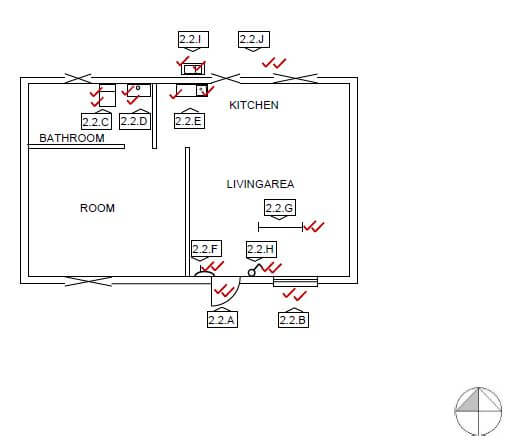
Outside door 2.2.A | 2 | |
Window 2.2.B | 2 | |
Water closet 2.2.C | 2 | |
Washbasin 2.2.D | 2 | |
Wash tub 2.2.E | 2 | |
One-way switch single pole 2.2.F | 2 | |
Fluorescent light 2.2.G | 2 | |
Socket outlet 2.2.H | 2 | |
Grease trap 2.2.I | 2 | |
Wall-mounted light 2.2.J | 2 | |
TOTAL: | 20 |
ANSWER SHEET B | CIVIL TECHNOLOGY WOODWORKING | NAME: |
4.5 Draw on ANSWER SHEET B to scale 1 : 10 a detailed sectional view of a closed (concealed) eave overhang of a roof truss. (22)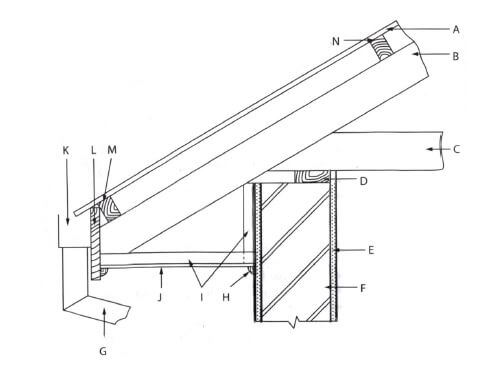
DRAWING NOT TO SCALE
ASSESSMENT CRITERIA | MARKS | CANDIDATE’S MARKS |
Corrugated iron sheeting/IBR sheeting | 1 | |
Rafter | 1 | |
Tie beam | 1 | |
Wall plate | 2 | |
Wall | 2 | |
Plaster | 2 | |
Downpipe | 2 | |
Quarter-round (moulding) | 1 | |
Soffit hanger | 2 | |
Soffit board | 2 | |
Gutter | 2 | |
Fascia board | 2 | |
Foot of purlin | 1 | |
Purlin | 1 | |
TOTAL: | 22 |
ANSWER SHEET C | CIVIL TECHNOLOGY WOODWORKING | NAME: |
6.5 Draw on ANSWER SHEET C the different methods that can be used to fix floor joist to walls. (10) 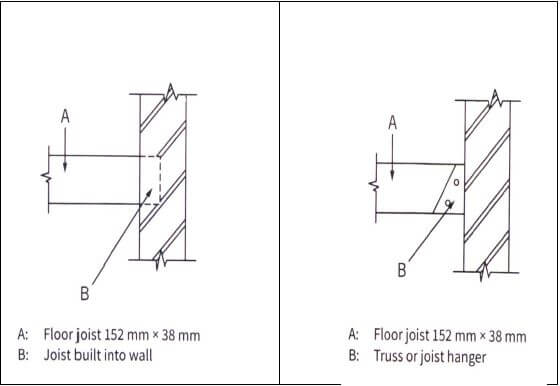
DRAWING NOT TO SCALE
ASSESSMENT CRITERIA | MARKS | CANDIDATE'S MARKS |
Joist build into wall | 2 | |
Floor joist | 2 | |
Scale | 1 | |
Joist bolted to wall with truss hanger | 2 | |
Truss or joist hanger | 2 | |
Scale | 1 | |
TOTAL | 10 |
Civil Technology Construction Grade 12 Memorandum - NSC Exams Past Papers and Memos September 2019 Preparatory Examinations
MEMORANDUM
QUESTION 1: SAFETY, OHSA AND MATERIAL (GENERIC)
1.1 3 m (1)
1.2 (1) By means of a chute or (2) conveyor belt (2)
1.3 Similar answer:
- (1) Prevents unauthorised entry and (2) to protect the public. (2)
1.4
1.4.1
- 30°
- 50° (2)
1.4.2
- 760 x 560 mm
3,7 m (2)
1.5
- 1 : 4 = 2 m = 0,5 m (one meter horizontal to four metres vertical) (2)
4
1.6 (1) Not further than 2/3 (2) of the extension length (2)
1.7 (1) The coating of a metal by means of electrolysis (2) with a thin layer of another metal. (2)
1.8 Any THREE advantages of electroplating of metals:
- Protects against corrosion
- Improves the engineering and mechanical properties of metal
- Increases the thickness of metal
- Resistant against wear and tear (3 x 1) (3)
1.9 Any TWO advantages of galvanising metals:
- Adds strength to the metal
- Increases the thickness of metal
- Prevents staining
- Protects against corrosion (2 x 1) (2) [20]
QUESTION 2: GRAPHICS, JOINING AND EQUIPMENT (GENERIC)
2.1
2.1.1 False (1)
2.1.2 True (1)
2.1.3 True (1)
2.1.4 True (1)
2.1.5 False (1)
2.2 FIGURE 2.2 on ANSWER SHEET A:
2.2.1 Outside door at 2.2.A (2)
2.2.2 Window at 2.2.B (2)
2.2.3 Water closet at 2.2.C (2)
2.2.4 Washbasin at 2.2.D (2)
2.2.5 Single sink unit at 2.2.E (2)
2.2.6 One-way switch single pole at 2.2.F (2)
2.2.7 Fluorescent light at 2.2.G (2)
2.2.8 Socket outlet at 2.2.H (2)
2.2.9 Grease trap at 2.2.I (2)
2.2.10 Wall-mounted light at 2.2.J (2)
2.3
2.3.1 Trim hexagon
2.3.2 Hex flange
2.3.3 Square shoulder screws (3)
2.4
2.4.1 Dumpy level (1)
2.4.2 Any ONE use of this instrument:
- Determine the difference in levels
- Determine levels and slopes
- Setting out buildings
- Transferring levels and heights (1 x 1) (1)
2.4.3
- – Focussing knob
- – Eye piece
- – Foot piece
- – Objective (4 x 1) (4)
2.4.4 (1) To obtain a level / horizontal (2) sight line / reading (2)
2.5 (1) If the moisture inside the level freezes and later reaches normal operating temperature, the moisture can condense (2) inside the tool, where it may damage the circuit board (2)
2.6
- M08 = Thread diameter
- 25 = Thickness (2) [40]
TOTAL SECTION A: 60
QUESTION 3: ROOFS, STAIRCASES AND JOINING (SPECIFIC)
3.1
3.1.1 Flat roof (1)
3.1.2 Mono-pitched roof (1)
3.1.3 1 400 mm / 1,4 m (1)
3.1.4 38 x 38 mm (1)
3.2 Any THREE requirements that roof trusses should meet:
- Sturdy enough to carry the roof covering safely
- Able to withstand wind and other forces that act on them
- Provide adequate height in rooms below the roof and ceiling assembly
- Should not allow the accumulation of rainwater upon the roof surface
- Neat and solid to enhance the appearance of the building (3)
3.3 Any THREE advantages with the use of roof underlays:
- Act as a secondary roof
- A weather shield during construction
- Waterproof and weatherproof
- Condensation barrier
- Dustproof
- Protects the building / structure
- Protects thermal insulation material
- Protects ceiling boards
- Superior wind uplifting strength prevents lifting of tiles
- Vapour resistant
- High tensile resistance
- Cost effective
- High heat resistance (3)
3.4
3.4.1 South African roof / Howe roof (1)
3.4.2 A – Rafter (1) B – Queen post (1) C – King post (1) D – Strut (1)
3.4.3 Span width more than 5 m (1)
3.4.4 114 (1) x 38 mm (1) (2)
3.5 Any TWO types of materials that staircases can be made from:
- Timber
- Concrete
- Bricks
- Metal (2)
3.6  (4)
(4)
3.7 2 100 mm / 2,1 m (1)
3.8 100 mm (1)
3.9
3.9.1 Anchor / Galvanised steel straps / Hoop iron / Wires (1)
3.9.2 Bolted / Nailed / Galv. steel straps / Hoop iron / Wires (1)
3.9.3 Bolted / Welded / Glued (1)
3.9.4 Cast-in anchors / Bolted (1) [30]
QUESTION 4: MATERIAL, EXCAVATIONS, EQUIPMENT AND TOOLS (SPECIFIC)
4.1
4.1.1 F (tested on site) (1)
4.1.2 G (high volume of concrete) (1)
4.1.3 E (ferrous metals) (1)
4.1.4 C (tested in a laboratory) (1)
4.1.5 A (small volume of concrete) (1)
4.1.6 B (non-ferrous metals) (1)
4.2 Any FOUR types of apparatus for the slump test:
- Slump test cone / mould
- Base plate
- Tamping rod
- Ruler / Tape measure
- Spirit level / Rod (4)
4.3 Any TWO – Discuss the purposes of the cube test:
- Determine the maximum compressive strength of cured concrete with load
- Ensure concrete complies with requirements of project specifications
- Indicate compressive strength in MPa, thus its ability to resist loads (2)
4.4 Draw a neat sketch of a normal failure of a cube test: (3)
(3)
4.5 Any TWO – Discuss the purposes of cladding to external surfaces of buildings:
- Aesthetic purposes
- Functional purposes
- Help to control weather elements (rain / wind)
- Prevent runoff (water) from penetrating the building (3)
4.6 Any TWO methods of fixing cladding:
- Adhesive fixing
- Face fixing
- Proprietary fixing (2)
4.7 Any THREE safety factors and regulations that a site manager must have in place, before excavation commences:
- Ensure a competent person evaluates the stability of the ground
- Draw up safety plan and take steps to ensure safe working conditions
- Ensure that planned excavations / trenches be supported by a protective system (formwork / shoring) and are indicated on safety plan
- Eliminate as many risks / hazards as possible
- Erect fencing (at least one metre high) around perimeter of excavations
- All excavations done under qualified supervision
- Carry out inspections to determine position of services (cables, pipes etc.) (3)
4.8
4.8.1 Fencing / Warning signs / Warning lights / Covering (1)
4.8.2 All workers must wear protective clothing (1)
4.8.3 With a ladder / scaffolding (1)
4.8.4 Inspections must be done daily (1)
4.9
4.9.1 True (1)
4.9.2 True (1)
4.9.3 False (1)
4.9.4 False (1)
4.10
4.10.1 Firm ground / Hard ground (1)
4.10.2
- – Poling boards (1)
- – Strut (1)
- – Walling boards (1)
- – Folding wedges (1)
4.11
4.11.1 Plate compactor (1)
4.11.2 Any THREE ways to care and maintain the plate compactor:
- Maintain – lubricate and adjust to manufacturer’s instructions
- Clean after use and store in a safe, dry place
- Repair / replace damaged electrical cords
- Service regularly
- Remove loose dirt and soil after use
- Ensure that all parts are firmly attached (3) [40]
QUESTION 5: BRICKWORK, GRAPHICS, PLASTER AND SCREED (SPECIFIC)
5.1
5.1.1 Cavity wall (1)
5.1.2 270 mm (1)
5.1.3 Any THREE purposes of the gap in a cavity wall:
- Ensures that no water will penetrate the inner wall
- Provides insulation against heat
- Provides insulation against cold
- Provides insulation against sound (3)
5.2
5.2.1 Bedding sand (1)
5.2.2 Weep hole (1)
5.2.3 Pavements (1)
5.2.4 Air bricks (1)
5.2.5 Subgrade (1)
5.3
5.3.1 Butterfly pattern (1)
5.4 Any FOUR advantages of dry-laid paving:
- Very economical / Cheap
- Low initial installation cost
- Designed to accommodate lifting of individual pavers
- Can be easily repaired
- User-friendly installation materials
- Easy to repair underground utilities
- Can also be designed as a permeable pavement
- No off-gassing (harmful gasses) installation products are used (4)
5.5 Any TWO reasons for construction failure of paving:
- Concrete haunch is too thin to support itself and cracks / crumble under pressure
- Too little weight to retain the structure and keep paving in place
- Bond between the haunch and edge units is weak and crumbles easily
- Sub-base is not contained and will be washed out by groundwater (2)
5.6 Draw a neat partial sketch of the herringbone paving pattern: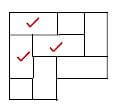 (3)
(3)
5.7 Any THREE advantages of beam filling:
- Prevents wind from penetrating the building
- Provides good insulation
- Prevents the perching / breeding of birds (open eave)
- Prevents insects from entering the roof and infesting the roof timber
- Prevents dust from entering the building
- Prevents small animals from entering the roof and ceiling (3)
5.8
5.8.1 True (1)
5.8.2 False (1)
5.8.3 True (1)
5.9
5.9.1 Semi-circular gauged arch (1)
5.9.2
- – Intrados (1)
- – Extrados (1)
- – Span (1)
5.10 Sand (1) and cement (1) (2)
5.11 Any ONE purpose of builder’s lime in a plaster mixture:
- Improves / enhances the workability of the mixture
- Improves the plasticity of the mixture
- Reduces cracking / crazing in the plaster (1)
5.12 Any TWO uses / purposes of interior plasterwork:
- Covers uneven, rough walls
- Improves sound insulation
- Improves fire resistance
- Prevents damage to the walls
- Provides a neat, hygienic finish to a house (2)
5.13 Any ONE purpose of a screed layer:
- To ensure a fine, smooth surface (paint)
- To ensure a flat, level surface (tiles) (1)
5.14
5.14.1 (2)
(2)
5.14.2  (2)
(2)
[40]
QUESTION 6: FORMWORK, REINFORCEMENT, FOUNDATIONS, CONCRETE FLOORS AND QUANTITIES (SPECIFIC)
6.1 Any ONE material that can be used to line the formwork, to obtain a smoother finish:
- Plastic
- Metal sheeting
- Hardboard
- Fibre-glass (1)
6.2
6.2.1
- – Bearer / head tree (1)
- – Brace / strut (1)
- – Prop / strut (1)
- – Soleplate (1)
6.3
6.3.1 Soft / mild steel (1)
6.3.2 200 mm (1)
6.3.3 10 mm (1)
6.4
6.4.1 Compressive forces (Anchor bars) (1)
6.4.2 Shear forces (Stirrups) (1)
6.5 Any ONE method of joining steel bars with wire:
- Crosswise method
- Hair knot method
- Crown method (1)
6.6 Any TWO purposes of the cover depth at the reinforcing of concrete work:
- To protect steel against corrosion
- To ensure adequate bonding between the steel and concrete
- To ensure adequate protection of steel in event of a fire (2)
6.7 Any TWO types of pile foundations:
- Precast concrete piles / prefabricated piles
- Steel tube caisson piles
- In-situ (driven) foundation piles
- Short-bored (auger) piles (2)
6.8 Any THREE reasons for using pile foundations:
- Ground conditions not stable / solid enough
- Distribute the load to more stable ground (underground / water supports)
- Provides stability when raft / floating foundation is used
- When structures are subjected to horizontal forces, resist pile foundations
- Pending stress while still lending vertical support
- Soils prone to swelling and shrinking (clay soil)
- Superstructure is exposed to uplifting forces (offshore platforms)
- Where soil erosion is possible (bridges) (3)
6.9
6.9.1 A Hollow-core blocks / Concrete floor block (1) B Rib / Reinforced ribs / Pre-stressed ribs (1)
6.9.2 Any ONE disadvantage of the rib-and-block floor construction:
- Mechanical handling for the ribs requires on site
- Manual labour required to place blocks between ribs (1)
6.10 Foundation strip - outside room is 5 500 x 3 250 (outside measurements). The foundation is 700 mm wide and 200 mm thick.
6.10.1 Calculate the centre-line of the foundation:
- 2 / 5 500 = 11 000
2 / 3 250 = 6 500
17 500
Min corners:
4 / 700 = 2 800
14 700 (5)
6.10.2 Calculate the volume of concrete required:
- Volume = length x width x thickness
= 14,7 m x 0,7 m x 0,2 m
= 2,058 m³ (4) [30]
TOTAL: 200
ANSWER SHEET A | CIVIL TECHNOLOGY GENERIC | NAME: |
2.2 Use the information on sheet A and complete the floorplan to scale 1 : 100. 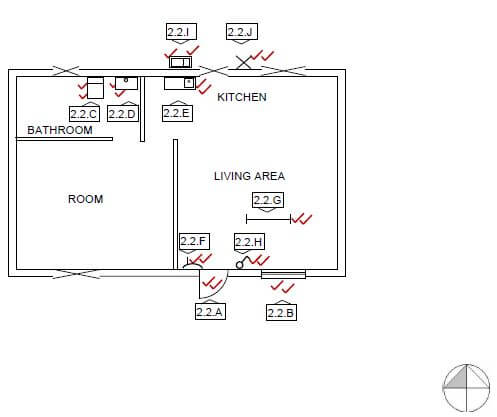
Outside door at 2.2.A | 2 | |
Window at 2.2.B | 2 | |
Water closet at 2.2.C | 2 | |
Wash basin at 2.2.D | 2 | |
Single sink unit at 2.2.E | 2 | |
One-way switch single pole at 2.2.F | 2 | |
Fluorescent light at 2.2.G | 2 | |
Socket outlet at 2.2.H | 2 | |
Grease trap at 2.2.I | 2 | |
Wall-mounted light at 2.2.J TOTAL: 20 | 2 | |
Civil Technology Construction Grade 12 Questions - NSC Exams Past Papers and Memos September 2019 Preparatory Examinations
REQUIREMENTS:
- ANSWER BOOK
- Drawing instruments
- A non-programmable pocket calculator
INSTRUCTIONS AND INFORMATION
- This question paper consists of SIX questions: TWO questions are generic and FOUR questions are subject specific.
- Answer ALL the questions.
- Answer each question as a whole. Do NOT separate subsections of questions.
- Start the answer to EACH question on a NEW page.
- Do NOT write in the margins of the ANSWER BOOK.
- You may use sketches to illustrate your answers.
- Write ALL calculations and answers in the ANSWER BOOK or on the attached ANSWER SHEET.
- Use the mark allocation as a guide to the length of your answers.
- Make drawings and sketches in pencil, fully dimensioned and neatly finished off with descriptive titles and notes to conform to the SANS/SABS Code of Practice for Building Drawings.
- For the purpose of this question paper, the size of a brick should be taken as 220 mm x 110 mm x 75 mm.
- Use your own discretion where dimensions and/or details have been omitted.
- Answer QUESTION 2.2 on the attached ANSWER SHEET using drawing instruments where necessary.
- Write your NAME on the ANSWER SHEET and hand it in with your ANSWER BOOK, whether you have answered the question or not.
- Due to electronic transfer, drawings in the question paper are NOT to scale.
QUESTIONS
QUESTION 1: SAFETY, OHSA AND MATERIALS (GENERIC)
Start this question on a NEW page.
1.1 What is the maximum height of a trestle scaffold? (1)
1.2 Building rubble should never be dropped from elevated areas. Name the correct method of disposing rubble from elevated areas. (2)
1.3 Briefly motivate why a construction site must be suitably cordoned off. (2)
1.4 Choose the correct answer from those in brackets with regards to the construction process of stairs:
1.4.1 Stairways must be installed at least (30° / 25°) from the horizontal platform and not more than (45° / 50°) from a wall. (2)
1.4.2 Stairways that will not be a permanent part of the building construction must have landings of at least (760 x 560 mm / 750 x 600 mm) for every (3,7 m / 2,5 m) or less vertical rise. (2)
1.5 FIGURE 1.5 shows a ladder that is placed against a wall. What is the correct measurement at A to keep it stable? Show or indicate how to achieve the ratio. 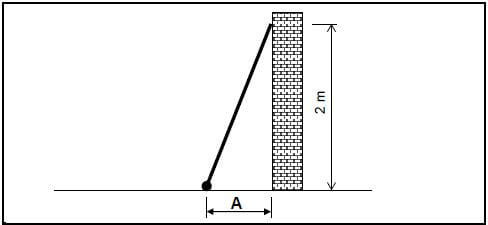
FIGURE 1.5 (2)
1.6 Explain the safety requirements when extending a ladder. (2)
1.7 Briefly explain the electroplating process of metals. (2)
1.8 Name THREE advantages of electroplating metals. (3 x 1) (3)
1.9 Name TWO advantages of galvanising metals. (2 x 1) (2) [20]
QUESTION 2: GRAPHICS, JOINING AND EQUIPMENT (GENERIC)
Start this question on a NEW page.
2.1 Indicate if the following statements, regarding site plans, are TRUE or FALSE. Write only ‘true’ or ‘false’ next to the question number in your ANSWER BOOK.
2.1.1 Scale 1 : 10 is used (1)
2.1.2 Ground contours are shown (1)
2.1.3 Layout of sewage is shown (1)
2.1.4 The proposed work is indicated in red (1)
2.1.5 Floor finishing of rooms are shown (1)
2.2 FIGURE 2.2 on ANSWER SHEET A shows an incomplete floorplan of a flat to scale 1 : 100. Complete the floorplan by using the following information:
2.2.1 Outside door at 2.2.A (2)
2.2.2 Window at 2.2.B (2)
2.2.3 Water closet at 2.2.C (2)
2.2.4 Washbasin at 2.2.D (2)
2.2.5 Wash tub at 2.2.E (2)
2.2.6 One-way switch single pole at 2.2.F (2)
2.2.7 Fluorescent light at 2.2.G (2)
2.2.8 Socket outlet at 2.2.H (2)
2.2.9 Grease trap at 2.2.I (2)
2.2.10 Wall-mounted light at 2.2.J (2)
2.3 Identify the different types of bolts in FIGURES 2.3.1, 2.3.2 and 2.3.3.  (3)
(3)
2.4 Answer the following questions on the tool in FIGURE 2.4. 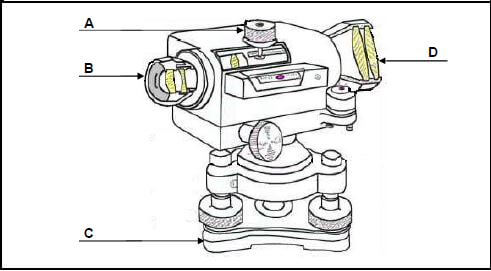
FIGURE 2.4
2.4.1 Identify the tool in FIGURE 2.4. (1)
2.4.2 Name ONE use of this tool. (1 x 1) (1)
2.4.3 Name the different parts A–D. (4 x 1) (4)
2.4.4 Name TWO uses of a laser level. (2)
2.5 Explain why the laser level should not be stored in extremely cold areas. Refer to the moisture inside the tool. (2)
2.6 Explain the meaning of the following code for Rawl bolts: M08/25. (2) [40]
TOTAL SECTION A: 60
QUESTION 3: ROOFS, STAIRCASES AND JOINING (SPECIFIC)
Start this question on a NEW page.
3.1 Identify the correct answer between brackets, e.g. 3.1.5 Purlin.
3.1.1 The slope of a (flat roof / double-pitched roof) is less than 10°. (1)
3.1.2 The (pitched roof / mono-pitched roof) slopes in one direction. (1)
3.1.3 The maximum spacing between roof trusses is (760 mm / 1 400 mm) when using corrugated iron sheets. (1)
3.1.4 The size of purlins is (38 x 38 mm / 50 x 76 mm) when using concrete roof tiles. (1)
3.2 Name THREE requirements that roof trusses should meet. (3)
3.3 Name THREE advantages of the use of roof underlays. (3)
3.4 Answer the following questions in regard to the roof truss in FIGURE 3.4. 
FIGURE 3.4
3.4.1 Identify the type of roof truss. (1)
3.4.2 Name parts A–D. (4)
3.4.3 What is a suitable span for this roof truss? (1)
3.4.4 What are the measurements (sizes) of part E? (2)
3.5 Name TWO types of material from which staircases can be made. (2)
3.6 Make a neat sketch of a typical step in the ANSWER BOOK. Show with labels the tread / going and the riser. (4)
3.7 What is the minimum headroom (height) at staircases, from the pitch line to the ceiling? (1)
3.8 What is the maximum spacing of balusters that hold the handrail at staircases? (1)
3.9 Explain ONE method of joining the following materials:
3.9.1 Roof trusses to a brick wall (1)
3.9.2 Wall plate to a brick wall (1)
3.9.3 Metal to another metal (1)
3.9.4 Metal to concrete (1) [30]
QUESTION 4: MATERIAL, EXCAVATIONS, EQUIPMENT AND TOOLS (SPECIFIC)
Start this question on a NEW page.
4.1 Choose a description from COLUMN B that fits best with an item in COLUMN A. Write only the letter (A–H) next to the question number (4.1.1–4.1.6) in the ANSWER BOOK, e.g. 4.1.7 K.
| COLUMN A | COLUMN B |
4.1.1 Slump test |
|
(6 x 1) (6)
4.2 Name FOUR types of apparatus used for the slump test. (4)
4.3 Discuss the purposes of the cube test. (2)
4.4 Draw a neat sketch of a normal failure of the cube test in the ANSWER BOOK. (3)
4.5 Discuss the purposes of cladding of the external surfaces of buildings. (3)
4.6 Name TWO methods of fixing cladding. (2)
4.7 Name THREE safety factors and regulations that a site manager must have in place, before excavation may commence. (3)
4.8 Discuss the safety precautions during excavations with reference to the following:
4.8.1 Safeguarding of excavations (1)
4.8.2 Wearing of protective clothing (1)
4.8.3 Access to a deep excavation (1)
4.8.4 Carrying out inspections (1)
4.9 Identify the following statements as TRUE or FALSE:
4.9.1 Bracing is necessary where trenches are deeper than 1,5 metre. (1)
4.9.2 Benching can help prevent the sides of trenches from collapsing. (1)
4.9.3 Machinery must be two metres from the trench during excavations. (1)
4.9.4 Excavated soil must be 1,6 metres from trench edges. (1)
4.10 Answer the following questions in regard to the shuttering in FIGURE 4.10. 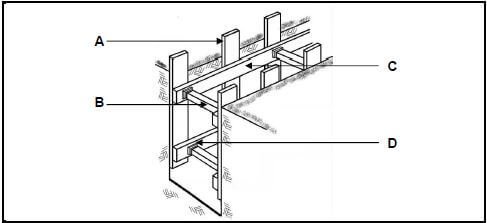
FIGURE 4.10
4.10.1 Identify the type of soil in FIGURE 4.10. (1)
4.10.2 Name parts A–D. (4)
4.11 Answer the following questions about the construction machine in FIGURE 4.11. 
FIGURE 4.11
4.11.1 Identify the machine. (1)
4.11.2 Name THREE ways of maintaining the machine. (3) [40]
QUESTION 5: BRICKWORK, GRAPHICS, PLASTER AND SCREED (SPECIFIC)
Start this question on a NEW page.
5.1 Answer the following questions about the wall construction in FIGURE 5.1. 
FIGURE 5.1
5.1.1 Identify the type of wall construction. (1)
5.1.2 What is the width of the wall? (1)
5.1.3 Name THREE purposes of the gap in the wall. (3)
5.2 Choose ONE term out of the list below for EACH of the following descriptions. Write only the term next to the question number (5.2.1–5.2.5) in the ANSWER BOOK, for example: 5.2.6 Wall plate.
| sub-base; air bricks; bedding sand; pavements; bitumen; weep hole; jointing; subgrade; walkways; wall ties |
5.2.1 The final layer upon which the paving units are laid (1)
5.2.2 Moist in a wall can escape through this (1)
5.2.3 The best edge restraint for kerbs (1)
5.2.4 Placed in the bottom course of the external walls in very wet regions (1)
5.2.5 The natural soil on which the paving will be laid (1)
5.3 Answer the following in regard to the wall tie in FIGURE 5.3. 
FIGURE 5.3
5.3.1 Identify the type of wall tie. (1)
5.4 Name FOUR advantages of dry-laid paving. (4)
5.5 Name TWO reasons for construction failure of paving. (2)
5.6 Draw a neat partial sketch of the herringbone paving pattern in the ANSWER BOOK. (3)
5.7 Name THREE advantages of beam-filling. (3) 5.8 Identify the following statements as TRUE or FALSE.
5.8.1 Beam-filling must be on the same height as the purlins. (1)
5.8.2 The central stone in an arch is called the bat brick. (1)
5.8.3 The lagging or profile of an arch wall is made from wood. (1)
5.9 Answer the following questions about the arch structure in FIGURE 5.9. 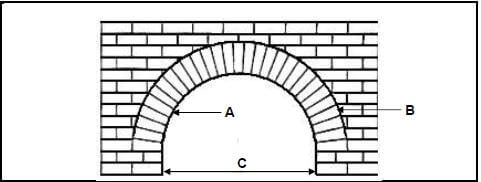
FIGURE 5.9
5.9.1 Identify the type of arch. (1)
5.9.2 Name the parts A–C. (3)
5.10 Name the ingredients of plaster (water and lime excluded). (2)
5.11 Name ONE purpose of builder’s lime in a plaster mixture. (1)
5.12 Name TWO purposes of interior plasterwork. (2)
5.13 Name ONE purpose of a screed layer. (1)
5.14 Draw the symbols of the following:
5.14.1 Electricity meter (2)
5.14.2 Water meter (2) [40]
QUESTION 6: FORMWORK, REINFORCING, FOUNDATIONS, CONCRETE FLOORS AND QUANTITIES (SPECIFIC)
Begin this question on a NEW page.
6.1 Name ONE material that can be used to line the formwork, to obtain a smoother finish of the concrete. (1)
6.2 Answer the following with regard to the formwork in FIGURE 6.2. 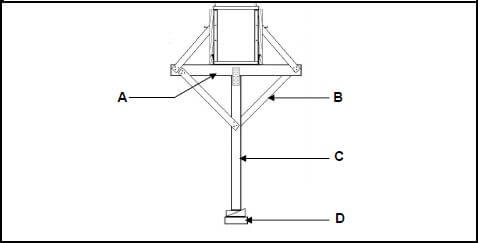
FIGURE 6.2
6.2.1 Name the parts A–D. (4)
6.3 Answer the following in regard to the bar code: 16R10-02-200
6.3.1 What type of steel is used? (1)
6.3.2 What is the spacing of the bars? (1)
6.3.3 What is the diameter of the bars? (1)
6.4 What forces are being counteracted by the following parts in concrete beam:
6.4.1 Anchor bars (1)
6.4.2 Stirrups (1)
6.5 Name ONE method of joining steel bars with wire. (1)
6.6 Name TWO purposes of the cover depth at the reinforcing of concrete work. (2)
6.7 Name TWO types of pile foundations. (2)
6.8 Name THREE reasons for the use of pile foundations. (3)
6.9 Answer the following questions in regard to the concrete floor in FIGURE 6.9. 
FIGURE 6.9
6.9.1 Name parts A–B. (2)
6.9.2 Name ONE disadvantage of this type of floor construction. (1)
6.10 FIGURE 6.10 shows a foundation strip for an outside room.
The foundation is 700 mm wide and 200 mm thick.
Answer the following questions in the ANSWER BOOK. 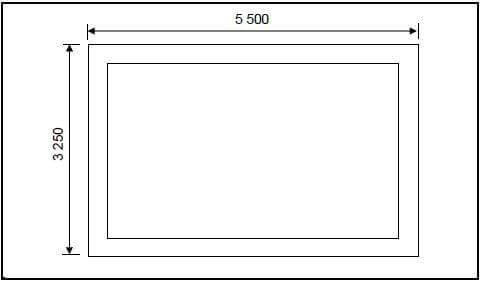
6.10.1 Calculate the centre-line of the foundation. (5)
6.10.2 Calculate the volume of concrete required. (4) [30]
TOTAL: 200
ANSWER SHEET A | CIVIL TECHNOLOGY GENERIC | NAME: |
2.2 Use the information on ANSWER SHEET A and complete the floor plan to scale 1 : 100. 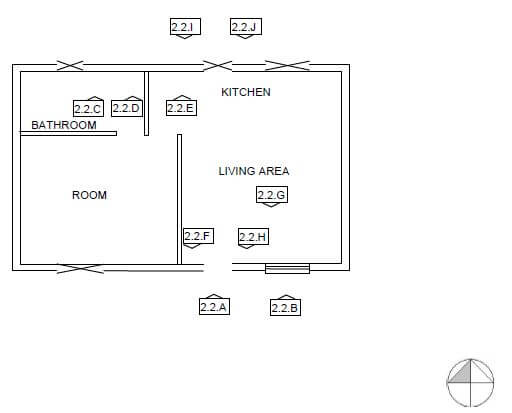
Outside door at 2.2.A | 2 | |
Window at 2.2.B | 2 | |
Water closet at 2.2.C | 2 | |
Washbasin at 2.2.D | 2 | |
Wash tub at 2.2.E | 2 | |
One-way switch single pole 2.2.F | 2 | |
Fluorescent light at 2.2.G | 2 | |
Socket outlet at 2.2.H | 2 | |
Grease trap at 2.2.I | 2 | |
Wall-mounted light at 2.2.J | 2 | |
TOTAL: | 20 |
Economics P1 Grade 12 Memorandum - NSC Exams Past Papers and Memos September 2019 Preparatory Examinations
MEMORANDUM
SECTION A (COMPULSORY)
QUESTION 1
1.1 MULTIPLE CHOICE QUESTIONS
1.1.1 C money ✓✓
1.1.2 D Phillips ✓✓
1.1.3 A reserve assets ✓✓
1.1.4 A money ✓✓
1.1.5 B moral suasion ✓✓
1.1.6 B Joint Initiative on Priority Skills Acquisition ✓✓
1.1.7 D Integrated Manufacturing Strategy ✓✓
1.1.8 C formation ✓✓ (8 x 2) (16)
1.2 MATCHING ITEMS
1.2.1 H C+G+I+(X-M) ✓
1.2.2 F obtained when the effects of irregular events and seasons are removed from time series data ✓
1.2.3 A complete ban or embargo on certain goods from a certain country ✓
1.2.4 I one country can produce goods and services cheaper than another
1.2.5 B a passageway allowing access from one area to another ✓
1.2.6 C developed a new support programme for clothing and textiles ✓
1.2.7 D minister of Finance informs Parliament of any changes that have occurred since February ✓
1.2.8 E important social indicator ✓ (8 x 1) (8)
1.3 GIVE ONE TERM
1.3.1 Exogenous/monetarist view ✓
1.3.2 Taxes/taxation ✓
1.3.3 Transfer payment ✓
1.3.4 Urbanisation ✓
1.3.5 Repurchase rate/repo rate ✓
1.3.6 Land Restitution ✓ (6 x 1) (6)
TOTAL SECTION A: 30
SECTION B
Answer TWO of the three questions in this section in the ANSWER BOOK.
QUESTION 2: MACROECONOMICS
2.1
2.1.1 Name any TWO member countries of BRICS.
- Brazil ✓
- Russia ✓
- China ✓
- South Africa ✓
- India ✓ (Any 2 x 1) (2)
2.1.2 Why is the GDP at market prices normally higher than the GDP at factor cost?
- GDP at market prices takes into account the prices actually paid for buying goods and services which already includes indirect taxes. ✓✓
- Indirect taxes are added to GDP at factor cost to calculate GDP at market price which makes GDP at market prices higher. ✓✓
(Accept any other correct relevant response) (Any 1 x 2) (2)
2.2 DATA RESPONSE
2.2.1 Give an example of a leakage.
- Savings ✓
- Taxes ✓
- Imports ✓ (Any 1 x 1) (1)
2.2.2 What factor influences the size of the multiplier?
- A change in spending (mps) ✓
- A change in consumption (mpc) ✓
(Accept any other correct relevant response) (Any 1 x 1) (1)
2.2.3 Briefly describe the term multiplier
- A small initial increase in spending produces a larger than proportionate increase in aggregate national income. ✓✓
(Accept any other correct relevant response) (2)
2.2.4 Explain the effect on national income when injections are more than leakages.
- Injections that are more than leakages increase demand of goods and services. ✓✓
- More goods and services will be produced and more income will be generated. ✓✓
- National income increases. ✓✓
(Accept any other correct relevant response) (Any 1 x 2) (2)
2.2.5 Suppose the South African government spends R250m on the economy. Calculate the multiplier effect if mpc= 0,7. Show all calculations.
- α=1/1 – mpc.
=1/1 – 0,7 ✓
= 1/0,3
= 3,33 ✓
Multiplier effect = 3,33 x R250 m ✓
= R832,5 m ✓
OR - α = 1/mps
= 1/0,3 ✓
= 3,33 ✓
Multiplier effect = 3,33 x R250 m ✓
= R832,5 m ✓
NB: (one mark awarded for answer only) (4)
2.3 DATA RESPONSE
2.3.1 Except AfCTA, name any other free trade area in the world.
- The North American Free Trade Agreement (NAFTA) ✓
- Southern African Development Community (SADC) ✓
- European Free Trade Association (EFTA) ✓
- South Asian Free Trade Area (SAFTA) ✓
(Accept any other relevant correct response) (1)
2.3.2 Which trade protocol is behind the establishment of a single market in Africa?
- African Union (AU) ✓ (1)
2.3.3 Briefly describe the term free trade area.
- Free trade area is where restrictions such as tariffs and quotas have been removed. ✓✓
(Accept any other relevant correct response) (2)
2.3.4 Briefly explain the role of the World Trade Organisation as part of globalisation.
The role of WTO is to:
- Oversee the implementation and administering of trade agreements. ✓✓
- Identify non-compliance with trade agreements. ✓✓
- Resolve trade disputes. ✓✓
(Accept any other relevant correct response) (Any 1 x 2) (2)
2.3.5 How can Africa benefit from being a single market?
Africa can benefit through:
- A boost in intra-African trade. ✓✓
- An opportunity for African countries to increase the share of industrial goods in production and exports ✓✓
- Substantial opportunities for industrialisation and employment. ✓✓
(Accept any other relevant correct response) (Any 2 x 2) (4)
2.4 Discuss the length and amplitude of a business cycle.
LENGTH
- This is the time that it takes for a business cycle to move through one complete cycle. ✓✓
- It is measured from peak to peak/trough to trough. ✓✓
- It is useful to know the length because the length tends to remain relatively constant over time. ✓✓
- If business cycles have a longer length, we consider the economy to be strong. ✓✓
- If business cycles have a shorter length, we consider the economy to be weak ✓✓ (Any 2 x 2)
AMPLITUDE
- It is the difference between the total output between a peak and a trough. ✓✓
- It measures the distance of the oscillation of a variable from the trend line. ✓✓
- It is the intensity of the upswing and downswing in economic activity. ✓✓
- The larger the amplitude the more extreme the changes that may occur. ✓✓ (Any 2 x 2) (8)
2.5 Evaluate the effects of a currency depreciation in an economy.
Positives
Currency depreciation:
- Can be used as an expansionary monetary policy to counter cyclical measures to stimulate demand, profits, output and jobs when an economy is in recession. ✓✓
- Brings an improvement in the balance trade through higher export sales. ✓✓
- Provides a competitive boost to an economy through increasing the value of profits and income for a country’s businesses with investments overseas. ✓✓
- Leads to a positive multiplier within the circular flow of income and spending. ✓✓
Negatives
Currency depreciation:
- Makes it harder for the government to finance a budget deficit if foreign investors lose confidence. ✓✓
- Increases the cost of imports e.g. rising prices for essential foodstuffs, raw materials, which affects long-run productive potential of an economy. ✓✓
- Makes it hard to pay for a trade deficit that is owed to overseas creditors. ✓✓
(Accept any other correct relevant response) (8) [40]
QUESTION 3: ECONOMIC PURSUITS
3.1
3.1.1 Name TWO demand side approach policies to growth and development.
- Monetary policy ✓
- Fiscal policy ✓ (2)
3.1.2 How can interest rates be used by the South African Reserve Bank to stimulate production of goods and services?
- Decreasing interest rates increases consumer spending. ✓✓
- Production is stimulated as businesses and firms make large equipment purchases due to low cost of borrowing. ✓✓
- More goods and services will be produced in the long run to meet the increase in demand on goods and services. ✓✓
(Accept any other correct relevant response) (Any 1 x 2) (2)
3.2 DATA RESPONSE
3.2.1 Name ONE example of a country of the North divide.
- Canada ✓
- France ✓
- Italy ✓
- Germany ✓
- Japan ✓
- Russia ✓
- United Kingdom ✓
- United States ✓
- Australia ✓
- New Zealand ✓ (Any 1 x 1) (1)
3.2.2 Provide a characteristic of the group of countries represented by ‘South’
- Low standard of living ✓
- Lack of adequate infrastructure ✓
- Low life expectancy ✓
- Lack of education ✓
(Accept any other correct relevant response) (Any 1 x 1) (1)
3.2.3 Briefly describe the term globalisation.
- The worldwide interaction of economies with trade as an important element. ✓✓
(Accept any other correct relevant response) (2)
3.2.4 Briefly explain trade as a challenge of globalisation.
Trade is a challenge of globalisation as:
- Rich countries continue to subsidise production of their agricultural goods, making it difficult for developing countries to compete. ✓✓
- They do this while insisting that developing countries must remove their tariffs on manufactured goods. ✓✓
- Most of the world’s poor countries have very little foreign trade and blame globalisation for that. ✓✓
(Accept any other correct relevant response) (Any 1 x 2) (2)
3.2.5 How do countries in the North contribute to the destruction of the environment?
They contribute to the destruction of the environment by:
- Causing pollution through mass production of goods and services. ✓✓
- Causing climate change by being involved in high levels of industrial activities. ✓✓
- Exhausting natural resources due to over industrialisation. ✓✓
- Deforestation due to over industrialisation. ✓✓
(Accept any other correct relevant response) (Any 2 x 2) (4)
3.3 DATA RESPONSE
3.3.1 Name ONE category of the secondary sector.
- Manufacturing ✓
- Food processing ✓
- Oil refining ✓
- Energy production ✓
(Accept any other correct relevant response) (Any 1 x 1) (1)
3.3.2 What was the trend in the primary sector between 2017 and 2018?
- It is declining ✓ (1)
3.3.3 Briefly describe the term Gross Domestic Product
- Gross Domestic product is the value of all final goods and services produced within the borders of a country over a specific period. ✓✓
(Accept any other correct relevant response) (2)
3.3.4 Explain the use of per capita GDP figures.
- They are used to compare the standard of living of different countries. ✓✓
(Accept any other relevant correct response) (2)
3.3.5 How does the real growth of 0,8% negatively affect the economy?
- A low real growth of 0,8% is lower than the anticipated growth rate.
It affects the economy negatively by:- Reducing employment opportunities as firms are unable to hire more workers. ✓✓
- Decreasing demand of goods and services as consumer’s spending decreases. ✓✓
- Reducing investment confidence. ✓✓
(Accept any other correct relevant response) (Any 2 x 2) (4)
3.4 Briefly discuss cost of doing business as a supply-side approach in promoting growth and development in South Africa.
Transport costs ✓
- Transport options are air, road, rail and sea transport. ✓✓
- Government controls air and rail transport in South Africa. ✓✓
- A substantial proportion of cargo and passenger transport is moved by road. ✓✓
- Only a reliable rail service that is cheaper than road transport will turn this around. ✓✓
Communication costs ✓
- Communication options are in cable, signal and mail. ✓✓
- Government controls cable (land or fixed lines) and mail communication services. ✓✓
- Cable communication services in South Africa is one of the most expensive in the world but reasonably efficient. ✓✓
- High costs make IT services for businesses and individuals expensive and inhibits global competitiveness. ✓✓
Energy costs ✓
- Electricity and liquid fuels are the main sources of energy in South Africa. ✓✓
- Eskom is the only supplier (monopoly) ✓✓
- Government regulates the prices for petrol and paraffin ✓✓
- The prices for imported crude oil are linked to international market prices, which are high ✓✓
- High liquid energy prices undermine the efficiency of the economy ✓✓ (8)
3.5 How do international organisations such as the World Bank and United Nations standardise the indicators of member countries?
WORLD BANK
- The World Bank Group of Institutions provide definitions for a range of economic and social indicators. ✓✓
- In partnership with International Organisation for Standardisation (ISO), the World Bank provides standards which give world class specifications for products, services and systems. ✓✓
UNITED NATIONS
- Developed the best-known manual of economic indicators, the System of National Accounts (SNA). ✓✓
- It focuses on production, income and expenditure and how to avoid double counting. ✓✓
- It compiles data in the SARB Quarterly Bulletin in terms of the SNA specifications. ✓✓
(Accept any other correct relevant response) (8) [40]
QUESTION 4: MACROECONOMICS AND ECONOMIC PURSUITS
4.1
4.1.1 Name TWO types of business cycles.
- Kitchen cycles ✓
- Jugler cycles ✓
- Kuznets cycles ✓
- Kondratieff cycles ✓ (Any 2 x 1) (2)
4.1.2 How can SMMEs contribute to economic growth?
SMMEs can contribute to economic growth by:
- Increasing production processes. ✓✓
- Creating employment opportunities for structurally unemployed people. ✓✓
- Increasing competition. ✓✓
- Increasing opportunities for exports.✓✓
- Increasing entrepreneurial skills that will lead to higher production and investment. ✓✓
(Accept any other correct relevant response) (Any 1 x 2) (2)
4.2 DATA RESPONSE
4.2.1 Identify the demand curve that indicates a decrease in the demand for dollars?
- D2D2 ✓ (1)
4.2.2 What type of exchange rate system is currently used in South Africa?
- Free floating exchange rate system/ flexible exchange rate system ✓ (1)
4.2.3 Briefly describe the term devaluation.
- Devaluation refers to the deliberate decrease in the value of the currency in terms of another currency as a result of central bank intervention. ✓✓
(Accept any other correct relevant response) (2)
4.2.4 Explain ONE factor that can influence the demand for the dollar.
- Importing goods increases demand of foreign goods, therefore payment needs to be made in a foreign currency. ✓✓
- Payment for services from foreign countries needs to be made in foreign currency. ✓✓
- Buying shares or assets in another country increases the demand. ✓✓
- Tourists spending money overseas. ✓✓
- Repayment of debt borrowed from foreign countries. ✓✓
(Accept any other correct relevant response) (Any 1 x 2) (2)
4.2.5 What is the effect on the rand when there is a decrease in the demand for dollars?
A decrease in the demand of dollars will:
- US$ – Depreciates ✓
- The Rand appreciates ✓ Reason: The demand for rand increases from DD to D1D1 and the equilibrium point from e to f. ✓✓ The price will be fixed at R10 which is higher than R8. ✓✓
(Accept any other correct relevant response) (Any 2 x 2) (4)
4.3 DATA RESPONSE
4.3.1 In which year is the NDP aiming to eliminate poverty?
- 2030 ✓ (1)
4.3.2 Name ONE way how the government can reduce the poverty of the vulnerable groups in South Africa.
- Providing social grants ✓
- Improving quality of education ✓
- Offering skills training ✓
(Accept any other correct relevant response) (Any 1 x 1) (1)
4.3.3 Briefly describe the term economic development.
- It implies an increase in the capacity of the population to produce more goods and services ✓✓
- The process by which the standard of living improves. ✓✓
(Accept any other correct relevant response) (Any 1 x 2) (2)
4.3.4 What negative effect can the NDP have on taxpayers?
For implementation of the NDP the state will:
- Need more revenue, therefore more and higher taxation will be needed. ✓✓
(Accept any other correct relevant response) (1 x 2) (2)
4.3.5 How will the South African economy benefit from the implementation of the NDP?
The South African economy will benefit from NDP implementation by:
- Reducing youth unemployment/ providing young people with broader opportunities. ✓✓
- Increasing the competitive capacity of the economy. ✓✓
- Improving the standard of living of the people. ✓✓
- Increasing industrialisation. ✓✓
(Accept any other correct relevant response) (Any 2 x 2) (4)
4.4 Briefly discuss the demographic social indicators.
Population growth ✓
- Measuring population growth is important for delivering social services. ✓✓
- Identifying the size of the tax base. ✓✓
- South Africa’s population numbered 58 million in 2019. ✓✓
(Accept any other correct relevant response) (Any 2 x 2)
Life expectancy ✓
- Estimated at 61 for males and 67 for females in South Africa. ✓✓
- Expresses the number of years a newborn infant will live if prevailing patterns of mortality remained the same. ✓✓
- Used by the government and assurance companies. ✓✓
- The government uses it to determine the range of social services. ✓✓
- Assurance companies use it to determine their premiums. ✓✓ (Any 2 x 2) (8)
4.5 How will an increase in export prices and import prices affect the South African economy?
An increase in export prices will:
- Result in terms of trade improving. ✓✓
- Increase economic welfare because more revenue is earned with the same expenditure. ✓✓
- However, over the long-term result in a decrease in sales volume depending on the price elasticity of demand. ✓✓
- Result in welfare loss eventually. ✓✓
An increase in import prices will:
- Result in terms of trade deteriorating. ✓✓
- Decrease welfare because more resources were used to produce more units to finance the higher cost of imports. ✓✓
(Accept any other correct relevant response) (8) [40]
TOTAL SECTION B: 80
SECTION C
QUESTION 5: MACROECONOMICS
Discuss in detail how the following factors contribute to poor public sector provisioning:
- Lack of accountability (10)
- Inefficiency (8)
- Difficulty in assessing needs (8)
Suggest solutions on how efficiency of state-owned enterprises can be improved.
INTRODUCTION
- The public sector consists of the central government responsible for national matters, provincial government responsible for regional matters and local government responsible for street lighting. ✓✓
(Accept any other correct relevant introduction) (2)
MAIN PART
Lack of Accountability
- Accountability means to give an explanation for one’s decisions, actions and expenditures. ✓✓
- The people require the state to use the taxes for the purpose for which they are raised and not to abuse the powers it was granted. ✓✓
- People employed by the state do not always serve the interests of the public. ✓✓
- They seek to maximise their salaries, status and power and are not required to produce a profit and loss statement. ✓✓
- They are budget driven. ✓✓
- The state tries to overcome this problem by making civil servants accountable to the public. ✓✓
In South Africa, accountability is underpinned by:
- Ministerial responsibilities: ministers are spokespersons for their departments. ✓✓
- The Director General of each department is accountable for the activities of the Department ✓✓
- Portfolio Committees: monitor individual departments and make recommendations to Parliament ✓✓
- Treasury control: the national treasury is responsible for expenditure control ✓✓
- The Treasury committee, chaired by the Minister of Finance, evaluates all requests for additional funding throughout the year ✓✓
- The Auditor-General reports on each government department ✓✓
- The AG reports on the standard of financial management and points out fraudulent and unauthorised spending ✓✓ (Max 10)
Inefficiency
- Accountability does not guarantee efficiency. ✓✓
- Public goods must be efficiently provided (Pareto efficiency where the welfare of the community is at its maximum and it is therefore impossible to increase the welfare of one individual without making another worse off) ✓✓
Three major reasons for inefficiency:
- Bureaucracy: ✓ (official rules and procedures) ✓✓
- Officials may focus on correct procedures and rules and are indifferent to the quantity (e.g. the number of patients attended to) ✓✓and quality of the service (e.g. explaining the use of the medicine) ✓✓
- Some may be insensitive to the needs of their clients ✓✓
- Incompetence: ✓ i.e. lack of skill or ability to do a task properly ✓✓
- This may be due to improper qualifications, lack of training, experience and an attitude of apathy. ✓✓
- Corruption: ✓ i.e. exploiting of a person’s position for personal gain ✓✓
- Taking bribes, committing fraud, nepotism, behaving dishonestly and committing discrimination. ✓✓ (Max. 8)
Difficulty in assessing needs
- In the private sector, the forces of demand and supply dictate prices ✓✓
- The market prices act as signals to the producers, communicating the needs of consumers and the quantity demanded ✓✓
- State-owned enterprises do not operate according to the forces of demand and supply ✓✓
- It therefore becomes difficult for state-owned enterprises to assess the needs of consumers and they are prone to under-or over-supplying public goods✓✓
- People’s needs are endless, so the government is unable to provide for everyone ✓✓
- Serious structural weaknesses in the economy also cause the government to undersupply in response to the needs that it identifies ✓✓
- Political agendas are more important than the needs that the government identifies ✓✓ (Max. 8)
ADDITIONAL PART
Suggest solutions on how efficiency of state-owned enterprises can be improved.
Efficiency of state-owned enterprises (SOEs) can be improved by:
- Having proper and clear guidelines to fight corruption ✓✓
- Forming Private Public Partnerships to enable a faster, more efficient delivery of goods and service. ✓✓
- Setting clear costing and development mandates with financial implications clearly set out. ✓✓
- Developing a framework for the appointment and remuneration of members to the Board of State-owned companies. ✓✓
- Ensuring efficient management. ✓✓
- Focusing on scarce resources for highest financial impact, ✓✓ e.g. encouraging a competitive work culture by hiring and retaining talented individuals through competitive compensation packages. ✓✓
(Accept any other correct relevant response) (10)
Conclusion
Efficient public sector provisioning in South Africa is key for a higher growth rate, higher employment rate and a better standard of living of all ✓✓
(Accept any higher order relevant conclusion) (2) [40]
QUESTION 6: ECONOMIC PURSUITS
Discuss in detail the appropriateness of South Africa’s regional development policies in terms of international benchmark criteria. (26)
How successful has the SA government been in meeting the aims of regional development? (10)
INTRODUCTION
Regional development is the promotion of economic development in areas where poverty, unemployment and income inequality are high. ✓✓
(Accept any correct relevant introduction)
MAIN PART
- Competitiveness ✓
- Industries established as a result of regional policies should be competitive. ✓✓
- Industries should not need on-going financial aid from the state ✓✓
- They should be self-sufficient in the long run and not depend on the state ✓✓
- Sustainability ✓
- The capacity of a region has to support its own development. ✓✓
- The natural resources and human resources should be harnessed. ✓✓
- Employment and sustainable development should be achieved. ✓✓
- Development should be a long-term approach rather than profit making. ✓✓
- Good governance ✓
- Development strategies to be managed effectively and free of corruption. ✓✓
- Principles of accountability and transparency should be applied. ✓✓
- Projects to be correctly programmed monitored and evaluated. ✓✓
- Efficient financial control to be exercised. ✓✓
- Partnership ✓
- Regional development should be the responsibility of different stake holders. ✓✓
- Partnership to be built between government, civil society, special interest group and private sector. ✓✓
- Provision of resources ✓
- Sufficient resources should be provided in resource poor areas, such as the development of infrastructure. ✓✓
- Provision of infrastructure to be a priority ✓✓
- Free market orientation ✓
- Government intervention in markets should be kept to a minimum so that the forces of supply and demand and profit motive can allow for efficient allocation of resource. ✓✓
- Markets to be allowed to function independently. ✓✓
- Integration ✓
- An integrated approach should be followed, ensuring that benefits in one part of a region spill over to other industries and areas. ✓✓
- Investing of social capital ✓
- Government need to improve the quality of education and health care in a Region. ✓✓
- Government must build more schools in different regions. ✓✓ (Max. 26)
ADDITIONAL PART
South Africa has been successful in achieving regional development aims because:
- There has been an existence of vibrant economic activities in different regions. ✓✓
- An estimated 80% of the country’s GDP is produced in various industrial areas. ✓✓ e.g. Johannesburg-Pretoria-Tshwane, Durban-Pinetown, Port Elizabeth-Coega-Uitenhage, Maputo development corridor, Richards Bay (Metals), Phalaborwa SDI ✓
- The department of Trade and Industry has formed a partnership with private sector through the Spatial Development Initiative, ✓✓ that shows that the government together with other stakeholders is committed to improving development. ✓✓
South Africa has been unsuccessful in achieving regional development aims because:
- There has been a lack of accountability in most public enterprises. ✓✓
- Mismanagement of funds puts the state under pressure to bail out these enterprises when they cannot make profit. ✓✓
- The quality of service in hospitals and clinics has not improved in various regions. ✓✓
- The country has not been able to attract significant flows of investment ✓✓
- There have been shortages of infrastructure in most regions ✓✓
(Accept any other correct relevant response) (Max. 10)
CONCLUSION
The long-term success of achieving economic development lies in the way the industrial policies are implemented. ✓✓
(Accept any other relevant higher order conclusion) (Max. 2) [40]
TOTAL SECTION C: 40
GRAND TOTAL: 150